*NURSING > QUESTIONS & ANSWERS > NURSING 326 : Psychiatric Mental Health Nursing Tests 1&2 - Latest 2019/20 Test Bank, Grade A work. (All)
NURSING 326 : Psychiatric Mental Health Nursing Tests 1&2 - Latest 2019/20 Test Bank, Grade A work.
Document Content and Description Below
NURSING 326 Psychiatric Mental Health Nursing Test Bank (2020) Psychiatric Mental Health Nursing Test Part 1 1. Your patient is very dependent and submissive. There are times that the patient is very ... clingy. This behavior reflects what type of personality disorder? a. Antisocial personality b. Dependent Personality c. Manic behavior d. Anxiety disorder Dependent personality is characterized by dependence, submission and being clingy. Antisocial personality is impulsive, aggressive and manipulative. 2. The appropriate therapeutic distance between you and a psychiatric patient is? a. 12 inches b. 35 inches c. 12 feet d. 4 feet Intimate zone: 0-18 inches. Parents with young children, people who mutually desire personal contact, or people whispering. Personal zone: 18-36 inches. Between family and friends talking. Social zone: 4-12 feet. Communication in social, work and business settings. Public zone: 12-25 inches. Speaker and an audience. Therapeutic distance: 3-6 feet. 3. Nurse Anna is instructing the new nurse to the psychiatric set-up. She also reminded her to use her therapeutic communication skills in dealing with clients. Which of the following techniques enlaces therapeutic communication? a. What are you thinking about? b. What made you think that way? c. Why did you say that? d. Let’s not talk about that. What do you think? This is using the therapeutic technique BROAD OPENING that allows the client to take the initiative to introduce a topic. 4. Mr. Juan is diagnosed with Alzheimer’s disease. The nurse’s intervention should focus on helping the client be oriented with the physical set-up and daily events. Which of the following is the most effective nursing intervention in orienting patients who has Alzheimer’s disease? a. Encourage the client to talk to family members to reminisce things b. Provide simple and easily understood directions c. Perform tasks with a variety of activities each day d. Have the client socialize with other patients Providing a daily routine and directions easily understood by the client would help orienting a client with Alzheimer’s disease. 5. A therapy that focuses on the remotivation of clients by directing their attention outside themselves to relieve preoccupation with personal thoughts, feelings, and attitudes is known as: a. Pharmacologic therapy b. Music therapy c. Occupational therapy d. Recreational therapy Recreational therapy- Focuses on remotivation of clients by directing their attention outside themselves to relieve preoccupation with personal thoughts, feelings, and attitudes. Clients learn to cope with stress through activity. Activities are planned to meet specific needs and encourage the development of leisure-time activities or hobbies. Recreational therapy is especially useful with those people who have difficulty relating to others (e.g., the regressed, withdrawn, or immobilized person). Examples of recreational activities include group bowling, picnics, sing-along, and bingo. 6. The 12-year old male patient looks like the nurse’s younger brother who is missing for years. During assessment and in the implementation of nursing care the nurse prioritizes this client. One day, when she found the boy crying in his room she hugged him and cried with him. This is an example of: a. Counter-transference b. Transference c. Resistance d. Denial When the nurse displays affection or emotion toward the client counter-transference is occurring. Transference is observed when the patient is displaying emotions towards the nurse. 7. A schizophrenic client is under your care. In reinforcing the functional behavior of this client what will the nurse do? a. Enumerate the symptoms of schizophrenia to the client b. Correct delusional thoughts to orient to reality c. Compliment the client for cessation of acting out behaviors d. Encourage the client to drink his medications religiously According to B.F. Skinner’s behavior medication technique, a client should be praise for good behaviors to help him modify his faulty actions. 8. A client was brought to the ER. Based on the significant others, the client had a history of shop stealing. However, no self-mutilating activities are committed by the client. During the interview, the client is very manipulative and aggressive and impulsive. What personality disorder most likely the client has? a. Antisocial b. Histrionic c. Narcissistic d. Borderline Antisocial P.D is characterized by aggression, manipulation and impulsivity. Histrionic people are emotional, dramatic and theatrical. Narcissistic people are boastful, egotistical and have superiority complex. Borderline PD is characterized by impulsivity, self-destruction and very unstable mood. 9. When the client told the nurse that he feels good when he mutilates or cuts himself the novice psychiatric nurse answered, “Do you know the risks involved when you cut yourself?” what type of nontherapeutic communication is the nurse using? a. Defending b. Testing c. Making stereotyped comments d. Disagreeing Testing is appraising a client’s degree of insight such as by asking the patient of the risks involved when he cut himself. This forces the client to recognize his problems. Defending is attempting to protect someone from a verbal attack. Stereotyped comments are meaningless clichés such as “it’s for your own good.” 10. A therapy that assists with discharge planning and rehabilitation, focusing on vocational skills and activities of daily living (ADL) to raise self-esteem and promote independence is called: a. Behavior modification b. Milieu therapy c. Recreational therapy d. Occupational therapy Occupational therapy - Assists with discharge planning and rehabilitation, focusing on vocational skills and activities of daily living (ADL) to raise self-esteem and promote independence 11. Nurse Marie is caring for a patient that underwent alcohol detoxification. Which of the following symptoms would Nurse Marie be most concern? a. Fever b. Delusions c. Excessive sweating d. Increase BP Once hallucinations and delusions are present; the client’s condition will most likely progress to delirium tremens. 12. The Distance that is observed when family members or friends are talking is under what zone: a. Intimate b. Therapeutic c. Personal d. Social Personal zone: 18-36 inches. Between family and friends talking. Intimate zone: 0-18 inches. Parents with young children, people who mutually desire personal contact, or people whispering. Social zone: 4-12 feet. Communication in social, work and business settings. Therapeutic distance: 3-6 feet. 13. The client is sharing Nurse Marie about his experiences. Suddenly, he paused, looked to the nurse and is hesitant to continue. The nurse responded, “Go on, and tell me about it.” What therapeutic communication technique is the nurse using? a. Exploring b. Focusing c. Encouraging expression d. General leads General leads indicate that the nurse is listening and following what the client is saying without taking away the initiative for the interaction. They also encourage the client to continue if he or she is hesitant or uncomfortable of the topic. Examples include, “Go on,” “Tell me about it,” and “And then?” 14. In a therapeutic communication, “why questions” are discouraged. For what reason is this question not useful? a. The question is intimidating and the client may be defensive in trying to explain him/herself. b. It forces the client to recognize his or her problems. The client’s acknowledgement that s/he doesn’t know things may be helpful to the nurse’s needs but not the client. c. It indicates that the client is right rather than wrong. d. It tends to make the client used and invaded. Using “why question” is asking to client the client to provide reasons for thoughts, feeling and behaviors. The question is intimidating and the client may be defensive in trying to explain him/herself. 15. An 18 year old client is brought to the ER due to a suicidal attempt. Her mother told the nurse that she has been drinking alcohol for the last 3 weeks and is depressed. In caring for this patient what is the most important consideration? a. Administering antidepressant medications b. Alcohol detoxification c. Allowing the client to participate in a therapy d. Close monitoring Safety is the most important consideration in client with a suicidal attempt. This is achieved by removing harmful objects around the client and monitoring the client closely. 16. In using a therapeutic communication technique interpreting client cues and signals is very important. Clear statements of intent such as the client saying that he wants to kill himself is a/an: a. Covert cues b. Abstract messages c. Concrete messages d. Overt cues Overt cues are clear statements of intent such as the client saying, “I want to die.” Covert cues are vague or hidden messages such as if a client verbalizes, “No one can help me.” Abstract messages are unclear patterns of words that often contain figures of speech that are difficult to interpret. Example is when the nurse asked the client, “What are you doing here?” Concrete messages are patterns of words that the nurse uses where words are explicit and does need an explanation. 17. A client was admitted due to self-mutilation. One day during one of the sessions, the client told the nurse that cutting himself feels great. What would be the nurse’s best response? a. “Do you know the risks involved when you cut yourself?” b. “I don’t want to hear about that!” c. “The behavior of cutting is not acceptable.” d. “Tell me more about that.” Presenting reality is the best in this situation as it is obvious that the client is misinterpreting the reality. Asking the client to tell the nurse more about is validating the actions of cutting himself. 18. A behavior that can indicate the speaker’s thoughts, feelings, needs and values that he or she acts out unconsciously is called: a. Verbal communication b. Communication c. Nonverbal communication d. Congruent message Nonverbal communication is the behavior that accompanies verbal content such as body language, eye contact, facial expression, tone of voice, speed and hesitations in speech, grunts and groans and distance from the listeners. This type of communication can indicate the speaker’s thoughts, feelings, needs and values that he or she acts out unconsciously. 19. Restraints are only used for a certain reason. Which of the following is an appropriate reason for placing a client in restraints? a. Punishment for stealing the other client’s things b. Self- harming behaviors c. Verbal abuse d. Not drinking medications One the patient attempts to harm himself, restraints is acceptable. 20. If a client is on restraints which of the following would the nurse do? a. Leave the client in the room for the whole 8 hours b. Do not allow the client to eat c. Take pictures of the client for evaluation d. monitor the extremity circulation When a client is placed on restraint, monitor the circulation to prevent physiologic damage of the extremity. 21. A client is scheduled for an electroconvulsive therapy (ECT). Which of the following medications can be given to the client before the procedure? a. Atropine b. Epinephrine c. Hydralazine d. Phenobarbital Before ECT atropine can be given to the client to decrease oral and respiratory function thereby preventing risks of aspiration. Atropine is antiarrythmic and at the same time an anticholinergic medication. 22. To ensure that your client knows about the procedure, risks and outcome and has been informed of the other alternative therapy. Which of the following must be accomplished? a. A signed informed consent by a client’s family member b. A signed informed consent by a 23-year old client who has voluntarily admitted himself in the unit. c. A signed informed consent of a 23-year old client’s parent d. A signed informed consent by a 17-year old client Clients of legal age can sign an informed consent. 23. The client says that he is hearing voices. What is nurse’s initial response? a. “I don’t hear any voices.” b. “From where are those voices coming from?” c. “What are the voices telling you?” d. “Are you sure about that?” Initially the nurse has to assess what the voices are telling the client to promote safety. Because if the voices are telling the client to kill himself or someone safety precautions must be implemented. 24. What is the most important criteria that must be accomplished by the nurse before dealing with psychiatric patients? a. Salary rate b. Self-awareness c. Self-understanding d. Standard of nursing practice Before a nurse can understand him/herself, being aware of what his/her strengths, weaknesses, limitations, belief and principles is very essential. A nurse who barely knows and understand herself cannot effectively establish a therapeutic communication with psychiatric clients. 25. If a client is a chain smoker, how should his medication dosage be adjusted? a. Same medication dose b. Increase the dose c. Decrease the dose d. Withhold the dose Smoking cigarettes increases the metabolism of some psychiatric medications, thus, medication dose should be increased. Psychiatric Mental Health Nursing Test Part 2 All the questions in the quiz along with their answers are shown below. Your answers are bolded. The correct answers have a green background while the incorrect ones have a red background. 1. Nurse Renalyn discovers that a male client with obsessive-compulsive disorder (OCD) is attempting to resist the compulsion. Based on this finding, the nurse should assess the client for: a. Feelings of failure b. Depression c. Excessive fear d. Increased anxiety An obsessive-compulsive client who attempts to resist the compulsion must be evaluated for increased anxiety. A compulsion is a repetitive, intentional behavior that the client performs in response to a certain obsession; it's aimed at neutralizing or decreasing anxiety. Resisting the compulsion may increase the client's anxiety. Although a client with OCD may have feelings of failure, depression, and excessive fear, these aren't responses to resisting the compulsion. 2. A female client comes to the emergency department while experiencing a panic attack. Nurse Jonathan can best respond to a client having a panic attack by: a. Staying with the client until the attack subsides b. Telling the client everything is under control c. Telling the client to lie down and rest d. Talking continually to the client by explaining what is happening The nurse should remain with the client until the attack subsides. If the client is left alone he may become more anxious. Giving false reassurance is inappropriate in this situation. The client should be allowed to move around and pace to help expend energy. The client may be so overwhelmed that he can't follow lengthy explanations or instructions, so the nurse should use short phrases and slowly give one direction at a time. 3. Nurse Krishna notices that a female client with obsessive-compulsive disorder dresses and undresses numerous times each day. Which comment by the nurse would be most therapeutic? a. "I saw you change clothes several times today. That must be very tiring." b. "Try to dress only once per day so you won't be so tired." c. "It bothers me to see you always so busy." d. "It's foolish to change clothes so many times in one day." Option A focuses on the client's feelings in an empathetic way, helping to reduce the intensity of the ritualistic behavior and promoting trust and rapport. Implying that the client's behavior is tiring, bothersome, or foolish would convey disapproval, impede trust and rapport, promote dysfunctional behavior, and worsen anxiety. 4. Nurse Luz is formulating a short-term goal for a client suffering from a severe obsessive-compulsive disorder (OCD). An appropriately stated short-term goal is that after 1 week, the client will: a. Demonstrate decreased anxiety. b. Participate in a daily exercise group. c. Identify the underlying reasons for rituals. d. State that the rituals are irrational. Participating in a daily exercise group refocuses the client's time toward adaptive activities and may reduce anxiety. Option A isn't stated specifically enough to allow for evaluation; for this goal to be measurable, specific objectives must be stated such as, "The client will verbalize feeling less anxious." Option C is incorrect because identifying the underlying reasons for rituals takes time and isn't a realistic goal after 1 week. Most clients with OCD are aware that the ritual is irrational but can't stop it, making option D inappropriate as well. 5. Because antianxiety agents such as chlordiazepoxide (Librium) can potentiate the effects of other drugs, nurse Raquel should incorporate which of the following instructions in her teaching plan? a. Avoid mixing antianxiety agents with alcohol or other central nervous system (CNS) depressants b. Avoid taking antianxiety drugs at bedtime c. Avoid taking antianxiety drugs on an empty stomach d. Avoid consuming aged cheese when taking antianxiety agents Potentiating effect refers to a drug's ability to increase the potency of another drug if taken together. Therefore, the client should be instructed to avoid alcohol while taking Librium because it potentiates the drug's CNS depressant effect. Taken at bedtime, this drug will induce sleep. Librium comes in capsule form and usually can be taken with water. Aged cheese is restricted with monoamine oxidase inhibitors, not Librium. 6. Danilo, arrives on the psychiatric unit exhibiting extreme excitement, disorientation, incoherent speech, agitation, frantic and aimless physical activity, and grandiose delusion. Which nursing diagnosis takes highest priority for the client at this time? a. Ineffective individual coping b. Hopelessness c. Risk for injury d. Disturbed identity This client is at increased risk for injury because of severe hyperactivity, disorientation, and agitation. Although the other options also are appropriate, the client's safety takes highest priority. The nurse should take immediate action to protect the client from injury. 7. Gina, age 18, is highly dependent on her parents and fears leaving home to go away to college. Shortly before the fall semester starts, she complains that her legs are paralyzed and is rushed to the emergency department. When physical examination rules out a physical cause for her paralysis, the physician admits her to the psychiatric unit where she is diagnosed with conversion disorder. The client asks nurse Rose, "Why has this happened to me?" What is the nurse's best response? a. "You've developed this paralysis so you can stay with your parents. You must deal with this conflict if you want to walk again." b. "It must be awful not to be able to move your legs. You may feel better if you realize the problem is psychological, not physical." c. "Your problem is real but there is no physical basis for it. We'll work on what is going on in your life to find out why it's happened." d. "It isn't uncommon for someone with your personality to develop a conversion disorder during times of stress." The nurse must be honest with the client by telling her that the paralysis has no physiologic cause while also conveying empathy and acknowledging that her symptoms are real. The client will benefit from psychiatric treatment, which will help her understand the underlying cause of her symptoms. After the psychological conflict is resolved, her symptoms will disappear. Saying that it must be awful not to be able to move her legs wouldn't answer the client's question; knowing that the cause is psychological wouldn't necessarily make her feel better. Telling her that she has developed paralysis to avoid leaving her parents or that her personality caused her disorder wouldn't help her understand and resolve the underlying conflict. 8. Dr. Luistro orders a new medication for a client with generalized anxiety disorder. During medication teaching, which statement or question by the nurse Kesselyn would be most appropriate? a. "Take this medication. It will reduce your anxiety." b. "Do you have any concerns about taking the medication?" c. "Trust us. This medication has helped many people. We wouldn't have you take it if it were dangerous." d. "How can we help you if you won't cooperate?" Providing an opportunity for the client to express concerns about a new medication and to make a choice about taking it can help the client regain a sense of control over his life. The client has the right to refuse the medication. Instead of simply ordering the client to take it, as in option A, the nurse should provide the information the client needs to make an informed decision. Attempting to make the client feel guilty, as in option C, or threatening the client, as in option D, would increase anxiety. 9. After seeking help at an outpatient mental health clinic, a client who was raped while walking her dog is diagnosed with posttraumatic stress disorder (PTSD). Three months later, the client returns to the clinic, complaining of fear, loss of control, and helpless feelings. Which nursing intervention is most appropriate for this client? a. Exploring the meaning of the traumatic event with the client b. Allowing the client time to heal c. Giving sleep medication, as prescribed, to restore a normal sleep-wake cycle d. Recommending a high-protein, low-fat diet The client with PTSD needs encouragement to examine and understand the meaning of the traumatic event and consequent losses. Otherwise, symptoms may worsen and the client may become depressed or engage in self-destructive behavior such as substance abuse. The client must explore the meaning of the event and won't heal without this, no matter how much time passes. Behavioral techniques, such as relaxation therapy, may help decrease the client's anxiety and induce sleep. The physician may prescribe antianxiety agents or antidepressants cautiously to avoid dependence; sleep medication is rarely appropriate. A special diet isn't indicated unless the client also has an eating disorder or a nutritional problem. 10. Jane is admitted to an inpatient psychiatric unit for treatment of obsessive-compulsive symptoms. Obsessive-compulsive disorder (OCD) is associated with: a. Physical signs and symptoms with no physiologic cause b. Apprehension c. Inability to concentrate d. Repetitive thoughts and recurring, irresistible impulses OCD is characterized by repetitive thoughts that the client can't control or exclude from consciousness, along with recurring, irresistible impulses to perform a particular action. Physical signs and symptoms with no physiologic cause typify somatoform disorder. Apprehension and inability to concentrate characterize anxiety disorders. 11. A client with obsessive-compulsive disorder and ritualistic behavior must brush the hair back from his forehead 15 times before carrying out any activity. Nurse Leo notices that the client's hair is thinning and the skin on the forehead is irritated — possible effects of this ritual. When planning the client's care, the nurse should assign highest priority to: a. Helping the client identify how the ritualistic behavior interferes with daily activities b. Exploring the purpose of the ritualistic behavior c. Setting consistent limits on the ritualistic behavior if it harms the client or others d. Using problem solving to help the client manage anxiety more effectively Client safety is the paramount concern and must be maintained. Therefore, setting consistent limits on potentially harmful ritualistic behavior takes highest priority. Although the other options are important, they take lower priority. For instance, helping the client identify how the ritualistic behavior interferes with daily activities increases the client's motivation for using more effective coping behavior. Exploring the purpose of the ritualistic behavior helps the client see this behavior as an attempt to control anxiety. As the client learns new ways to manage anxiety, the ritualistic behavior is likely to decrease. 12. During alprazolam (Xanax) therapy, nurse Rachel should be alert for which dose-related adverse reaction? a. Ataxia b. Hepatomegaly c. Urticaria d. Rash Dose-related adverse reactions to alprazolam include drowsiness, confusion, ataxia, weakness, dizziness, nystagmus, vertigo, syncope, dysarthria, headache, tremor, and a glassy-eyed appearance. These dose-related reactions diminish as therapy continues. Although hepatomegaly may occur with benzodiazepine use, this adverse reaction is rare and isn't dose-related. Idiosyncratic reactions to benzodiazepines may include a rash and acute hypersensitivity reactions; however, they aren't dose-related. 13. A client is admitted to the psychiatric unit with a diagnosis of conversion disorder. Since witnessing the beating of his wife at gunpoint, he has been unable to move his arms, complaining that they are paralyzed. When planning the client's care, nurse Jay should focus on: a. Helping the client identify and verbalize feelings about the incident b. Convincing the client that his arms aren't paralyzed c. Developing rehabilitation strategies to help the client learn to live with the disability d. Talking about topics other than the beating to avoid causing anxiety In conversion disorder, the client represses and converts emotional conflicts into motor, sensory, or visceral symptoms with no physiologic cause. Interventions should focus on helping the client identify the underlying emotional problem. A client with conversion disorder can't be convinced that the physical problem isn't real; attempts to convince him may lead him to seek other health care providers who may accept the reality of his symptoms. Treating the physical symptoms as long-term or permanent may encourage the client to maintain them. Ignoring the cause of the symptoms would prevent the client from dealing with his feelings about his wife's beating. 14. A male client with borderline personality disorder tells nurse Valerie, "You're the only nurse who really understands me. The others are mean." The client then asks the nurse for an extra dose of antianxiety medication because of increased anxiety. How should the nurse respond? a. "I'll talk to the physician right away. I don't think they give you enough medicine." b. "I'll have to discuss your request with the team. Can we talk about how you're feeling right now?" c. "I don't want to hear you say negative things about the other nurses." d. "You know you can't have extra medication. Why do you keep asking?" This response appropriately focuses on the emotional content of the client's message and helps the client identify feelings. Focusing on the request for extra medication would allow the client to ignore the underlying emotional issues. Clients with borderline personality disorder commonly divide the staff into "good guys" and "bad guys" to meet their needs; staff members must maintain consistency and a united front at all times. The nurse shouldn't take the client's statements personally because this would interfere with the ability to maintain a therapeutic relationship. 15. Angel, is admitted to the unit visibly anxious. When assessing her, the nurse would expect to see which of the following cardiovascular effects produced by the sympathetic nervous system? a. Syncope b. Decreased blood pressure c. Increased heart rate d. Decreased pulse rate Sympathetic cardiovascular responses to stress include increased heart rate, cardiac contractility, and cardiac output; increased blood pressure; and peripheral vasoconstriction. Syncope is a response to parasympathetic stimulation. 16. A male client with Alzheimer's disease has a nursing diagnosis of Risk for injury related to memory loss, wandering, and disorientation. Which nursing intervention should appear in this client's plan of care to prevent injury? a. Provide the client with detailed instructions b. Keep the client sedated whenever possible c. Remove hazards from the environment d. Use restraints at all times By removing environmental hazards, such as bottles of hydrogen peroxide and benzoin, the nurse can help prevent injury to the client. For a client with Alzheimer's disease, the nurse should provide single, simple instructions, rather than many detailed instructions. The nurse should administer medication as prescribed and as needed — not to keep the client sedated. The nurse should use restraints only when required to prevent self-harm by the client. 17. Rudy was found wandering in a local park is unable to state who or where he is or where he lives. He is brought to the emergency department, where his identification is eventually discovered. The client's wife states that he was diagnosed with Alzheimer's disease 3 years ago and has had increasing memory loss. She tells nurseAngelie she is worried about how she'll continue to care for him. Which response by the nurse would be most helpful? a. "Because of the nature of your husband's disease, you should start looking into nursing homes for him." b. "What aspect of caring for your husband is causing you the greatest concern?" c. "You may benefit from a support group called Mates of Alzheimer's Disease Clients." d. "Do you have any children or friends who could give you a break from his care every now and then?" The nurse should determine the specific concerns of the client's wife. Jumping to conclusions regarding the client's need for a nursing home or other care placement options would be inappropriate. The nurse must tailor care to the client and family, focusing on their needs. Although support groups, children, and friends may prove helpful to the client's wife, the nurse must establish a plan for continued care that addresses her specific concerns. 18. Nurse Agnes is aware that nursing action most appropriate when trying to diffuse a male client's impending violent behavior? a. Helping the client identify and express feelings of anxiety and anger b. Involving the client in a quiet activity to divert attention c. Leaving the client alone until he can talk about his feelings d. Placing the client in seclusion In many instances, the nurse can diffuse impending violence by helping the client identify and express feelings of anger and anxiety. Such statements as "What happened to get you this angry?" may help the client verbalize feelings rather than act on them. Close interaction with the client in a quiet activity may place the nurse at risk for injury should the client suddenly become violent. An agitated and potentially violent client shouldn't be left alone or unsupervised because the danger of the client's acting out is too great. The client should be placed in seclusion only if other interventions fail or the client requests this. Unlocked seclusion can be helpful for some clients because it reduces environmental stimulation and provides a feeling of security. 19. A male client has been taking imipramine (Tofranil), 125 mg by mouth daily, for 1 week. Now the client reports wanting to stop taking the medication because he still feels depressed. At this time, what is the best response of nurse Charlyn? a. "Imipramine may not be the most effective medication for you. You should call your physician for further evaluation." b. "Because imipramine must build to a therapeutic level, it may take 2 to 3 weeks to reduce depression." c. "The physician may need to increase the dosage for you to get the medication's maximum benefit." d. "Don't stop taking the medication abruptly because you may develop serious adverse effects." Antidepressant agents, such as imipramine, don't produce antidepressant effects until they reach a therapeutic level in the blood, usually about 2 to 3 weeks after the initial dose. Therefore, the nurse should encourage the client to continue therapy at least until the drug reaches that level. After this time, if the client's depression doesn't abate, the nurse may use the other responses. 20. A male client with Alzheimer's disease mumbles incoherently and rambles in a confused manner. To help redirect the client's attention, nurse Mark should encourage the client to: a. Fold towels and pillowcases b. Play cards with another client c. Participate in a game of charades d. Perform an aerobic exercise Folding towels and pillowcases is a simple activity that redirects the client's attention. Also, because this activity is familiar, the client is likely to perform it successfully. Cards, charades, and aerobic exercise are too complicated for a confused client. 21. Nurse Francis is aware that the nursing preparations for a client undergoing electroconvulsive therapy (ECT) resemble those used for: a. Physical therapy b. Neurologic examination c. General anesthesia d. Cardiac stress testing The nurse should prepare a client for ECT in a manner similar to that for general anesthesia. For example, the client should receive nothing by mouth for 8 hours before ECT to reduce the risk of vomiting and aspiration. Also, the nurse should have the client void before treatment to decrease the risk of involuntary voiding during the procedure; remove any full dentures, glasses, or jewelry to prevent breakage or loss; and make sure the client is wearing a hospital gown or loose-fitting clothing to allow unrestricted movement. Usually, these preparations aren't indicated for a client undergoing physical therapy, neurologic examination, or cardiac stress testing. 22. Nurse Hershey must administer activated charcoal before administering certain other drugs to a client who's taken an overdose. Which drug is rendered inactive when administered concomitantly with activated charcoal? a. Warfarin sodium (Coumadin) b. Ipecac syrup c. Simethicone (Phazyme) d. Famotidine (Pepcid) Ipecac syrup is rendered inactive when administered concomitantly with activated charcoal. 23. Dr. Tan orders electroconvulsive therapy (ECT) for a severely depressed client who fails to respond to drug therapy. When teaching the client and family about this treatment, nurse Bernadeth should include which most important point about ECT? a. An anesthesiologist will administer ECT b. ECT can cure depression c. ECT will induce a seizure d. The client will remember the shock of ECT but not the pain Reserved for clients with acute depression who don't respond to pharmacologic or psychiatric measures, ECT is the passage of an electrical current through the brain to induce a brief seizure. According to ECT proponents, the seizure causes desirable changes in neurotransmitters and receptor sites similar to those caused by antidepressant drugs. ECT is administered by a physician or an anesthesiologist. Although ECT may reduce the severity of depression, it doesn't necessarily cure it. Before ECT, the client receives a medication that provides short-term amnesia of the entire event. 24. Julius, an adolescent becomes increasingly withdrawn, is irritable with family members, and has been getting lower grades in school. After giving away a stereo and some favorite clothes, the adolescent is brought to the community mental health agency for evaluation. This adolescent is at risk for: a. Suicide b. Anorexia nervosa c. School phobia d. Psychotic break Changes in academic performance and familial communications, social withdrawal, and giving away of treasured possessions suggest that this adolescent is contemplating suicide. Anorexia nervosa would cause weight loss and other related symptoms. This adolescent's signs and symptoms don't suggest fear of school and typify depression, not psychosis. 25. Nurse Bea is aware the when preparing a client for electroconvulsive therapy (ECT), she should make sure that: a. The client sees family members immediately before the procedure b. The client is scheduled for a brain scan immediately after the procedure c. The client has undergone a thorough medical evaluation d. The client has received lithium carbonate (Lithonate) Before an ECT treatment, the nurse should ensure that the client has had a medical evaluation that includes an ECG, a chest X-ray, neurologic and laboratory tests, and spinal X-rays, if indicated. Although making sure that the client sees family members immediately before the procedure would be appropriate, it's unnecessary (unless the client requests this). A brain scan isn't required after ECT because it can't evaluate the therapeutic effects of this treatment. Lithium must be discontinued before ECT because it prolongs the effects of succinylcholine chloride (Anectine), a muscle relaxant given just before the shock is delivered. Psychiatric Mental Health Nursing Test Part 3 All the questions in the quiz along with their answers are shown below. Your answers are bolded. The correct answers have a green background while the incorrect ones have a red background. 1. A male adult client with bipolar disorder is being treated with lithium for the first time. Nurse Joy should observe the client for which common adverse effect of lithium? a. Sexual dysfunction b. Constipation c. Polyuria d. Seizures Polyuria commonly occurs early in the treatment with lithium and could result in fluid volume deficit. Sexual dysfunction isn't a common adverse effect of lithium; it's more common with sedatives and tricyclic antidepressants. Diarrhea, not constipation, occurs with lithium.Constipation can occur with other psychiatric drugs, such as antipsychotic drugs. Seizures may be a later sign of lithium toxicity. 2. Mr. Velasquez is brought to the crisis intervention center by his wife, who states that he has been increasingly listless and less involved with his family recently. She reports that he sleeps poorly, eats little, and can barely perform basic self-care activities. She also reveals that 3 months ago he was in a car accident in which his best friend was killed. After the physician diagnoses acute depression, the nurse should anticipate administering: a. paroxetine (Paxil), 20 mg by mouth (P.O.) every morning b. amitriptyline (Elavil), 20 mg P.O. daily c. doxepin (Sinequan), 500 mg daily d. imipramine (Tofranil), 500 mg daily All of the drugs listed are antidepressants that may be prescribed for this client. However, paroxetine, 20 mg P.O. every morning, is the only correct dosage. Amitriptyline is usually started at 75 to 150 mg P.O. daily in divided doses. Doxepin is started at 25 to 50 mg daily and may be titrated upward to a maximum daily dose of 300 mg. Imipramine is started at 50 to 75 mg daily and, if tolerated, titrated upward to a maximum daily dose of 300 mg. 3. Nurse Vanessa is administering venlafaxine (Effexor) 75 mg by mouth daily to a client diagnosed with depression. What type of agent is venlafaxine? a. Monoamine oxidase inhibitor b. Tricyclic antidepressant c. Second-generation antidepressant d. Lithium derivative Physicians prescribe venlafaxine to treat depressive disorders; the drug is a second-generation antidepressant agent 4. At night, Victor a geriatric client with senile dementia wanders into other clients' rooms, awakening them. What is the best nursing intervention for dealing with the client's insomnia and nocturnal roaming? a. Administer a benzodiazepine at bedtime as prescribed b. Administer a phenothiazine at bedtime as prescribed c. Administer a barbiturate at bedtime as prescribed d. Lock the client's door at bedtime In geriatric clients, phenothiazines are preferred for sedation and thought clearing. Benzodiazepines usually are avoided because of the risk of addiction, cardiovascular complications, and impaired motor coordination. Barbiturates also are avoided because they may cause delirium, confusion, excitement, and addiction. Locking the door is inappropriate and would violate the client's rights. 5. Catherine has received treatment for depression for 3 weeks. Which behavior suggests that the client is recovering from depression? a. The client talks about the difficulties of returning to college after discharge b. The client spends most of the day sitting alone in the corner of the room. c. The client wears a hospital gown instead of street clothes. d. The client shows no emotion when visitors leave. By talking about returning to college, the client is demonstrating an interest in making plans for the future, which is a sign of recovery from depression. Decreased socialization, lack of interest in personal appearance, and lack of emotion are all symptoms of depression. 6. Nurse Mary Anne is caring for a client who has been diagnosed with hypochondriasis. The client attributes his cough to tuberculosis. A chest X-ray and skin test are negative for tuberculosis. The client begins to complain about the sudden onset of chest pain. How should the nurse react initially? a. Let the client know the nurse understands his fears of serious illness. b. Encourage the client to discuss his fear of having a serious illness. c. Report the complaint of chest pain to the physician. d. Determine if the illness is fulfilling a psychological need for the client. Because of the risk of missing an actual medical problem, any new symptoms reported by a client with hypochondriasis should be reported to the physician. The other interventions are appropriate after the nurse has determined that the client doesn't have a serious medical disorder. 7. Linda, a 54-year-old was found unconscious on the floor of her bathroom with self-inflicted wrist lacerations. An ambulance was called and the client was taken to the emergency department. When she was stable, the client was transferred to the inpatient psychiatric unit for observation and treatment with antidepressants. Now that the client is feeling better, which nursing intervention is most appropriate? a. Observe for extrapyramidal symptoms. b. Begin a therapeutic relationship. c. Cancel any no-suicide contracts. d. Continue suicide precautions As antidepressants begin to take effect and the client feels better, she may have the energy to initiate and complete another suicide attempt. As the client's energy level increases, the nurse must continue to be vigilant to the risk of suicide. Extrapyramidal symptoms may occur with antipsychotics and aren't adverse effects of antidepressants. A therapeutic relationship should be initiated upon admission to the psychiatric unit, after suicide precautions have been instituted. It's through this relationship that the client develops feelings of self-worth and trust and problem-solving takes place. In a no-suicide contract, the client states verbally or in writing that she won't attempt suicide and will seek out staff if she has suicidal thoughts. When the time period for a contract has expired, a new contract should be obtained from the client. 8. Which of the following statements should be included when teaching a male client about monoamine oxidase inhibitor (MAOI) antidepressants? a. Don't take prescribed or over-the-counter medications without consulting the physician. b. Avoid strenuous activity because of the cardiac effects of the drug. c. Have blood levels screened weekly for leukopenia. d. Don't take with aspirin or nonsteroidal anti-inflammatory drugs (NSAIDs). MAOI antidepressants when combined with a number of drugs can cause life-threatening hypertensive crisis. It's imperative that a client checks with his physician and pharmacist before taking any other medications. Activity doesn't need to be limited. Blood dyscrasias aren't a common problem with MAOIs. Aspirin and NSAIDs are safe to take with MAOIs. 9. Michael,a teenager was driving a car that slipped off an icy road, killing two of his friends. He repeatedly tells the nurse that he should be dead instead of his friends. The client's behavior is an example of: a. survivor's guilt b. denial c. anticipatory grief d. repression Individuals who survive a traumatic experience in which others have died commonly report powerful feelings of guilt that they survived and others didn't. This guilt is referred to as survivor's guilt. In denial, a person refuses to accept that a situation or feeling exists. Anticipatory grief occurs when an individual experiences grief before a loss occurs. In repression, an individual involuntarily blocks an unpleasant experience, memory, or feeling from consciousness. 10. Angelo with a diagnosis of major depression is prescribed clonazepam (Klonopin) for agitation in addition to an antidepressant. Client teaching would include which of the following statements? a. Klonopin may interact with organ meats. b. The medications shouldn't be taken together. c. Klonopin is a minor depressant and may aggravate symptoms of depression. d. The order needs to be clarified; call the physician. Klonopin is a central nervous system (CNS) depressant and can aggravate symptoms in depressed clients. It doesn't interact with organ meats and can be taken with antidepressant medication. There is no need to call the physician; the medications can be safely taken together. 11. A male client is about to be discharged with a prescription for the antipsychotic agent haloperidol (Haldol), 10 mg by mouth twice per day. During a discharge teaching session, nurse Ericka should provide which instruction to the client? a. Take the medication 1 hour before a meal. b. Decrease the dosage if signs of illness decrease. c. Apply a sunscreen before being exposed to the sun. d. Increase the dosage up to 50 mg twice per day if signs of illness don't decrease. Because haloperidol can cause photosensitivity and precipitate severe sunburn, the nurse should instruct the client to apply a sunscreen before exposure to the sun. The nurse also should teach the client to take haloperidol with meals — not 1 hour before — and should instruct the client not to decrease or increase the dosage unless the physician orders it. 12. For several years, a client with chronic schizophrenia has received 10 mg of fluphenazine hydrochloride (Prolixin) by mouth four times per day. Now the client has a temperature of 102° F (38.9° C), a heart rate of 120 beats/minute, a respiratory rate of 20 breaths/minute, and a blood pressure of 210/140 mm Hg. Because the client also is confused and incontinent, nurse Ronie suspects malignant neuroleptic syndrome. What steps should the nurse take? a. Give the next dose of fluphenazine, call the physician, and monitor vital signs. b. Withhold the next dose of fluphenazine, call the physician, and monitor vital signs. c. Give the next dose of fluphenazine and restrict the client to the room to decrease stimulation. d. Withhold the next dose of fluphenazine, administer an antipyretic agent, and increase the client's fluid intake. Malignant neuroleptic syndrome is a dangerous adverse effect of neuroleptic drugs such as fluphenazine. The nurse should withhold the next dose, notify the physician, and continue to monitor vital signs. Although an antipyretic agent may be used to reduce fever, increased fluid intake is contraindicated because it may increase the client's fluid volume further, raising blood pressure even higher. 13. During a group therapy session in the psychiatric unit, Joyce constantly interrupts with impulsive behavior and exaggerated stories that cast her as a hero or princess. She also manipulates the group with attention-seeking behaviors, such as sexual comments and angry outbursts. Nurse Joey realizes that these behaviors are typical of: a. paranoid personality disorder b. avoidant personality disorder c. histrionic personality disorder d. borderline personality disorder This client's behaviors are typical of histrionic personality disorder, which is marked by excessive emotionality and attention seeking. The client constantly seeks and demands attention, approval, or praise; may be seductive in behavior, appearance, or conversation; and is uncomfortable except when she is the center of attention. Typically, a client with paranoid personality disorder is suspicious, cold, hostile, and argumentative. Avoidant personality disorder is characterized by anxiety, fear, and social isolation. Borderline personality disorder is characterized by impulsive, unpredictable behavior and unstable, intense interpersonal relationships. 14. Nurse Jason is teaching a psychiatric client about her prescribed drugs, chlorpromazine and benztropine. Why is benztropine administered? a. To reduce psychotic symptoms b. To reduce extrapyramidal symptoms c. To control nausea and vomiting d. To relieve anxiety Benztropine is an anticholinergic medication, administered to reduce the extrapyramidal adverse effects of chlorpromazine and other antipsychotic medications. Benztropine doesn't reduce psychotic symptoms, relieve anxiety, or control nausea and vomiting. 15. Dr. Ryan would probably be ordered medication for the acutely aggressive schizophrenic client? a. chlorpromazine (Thorazine) b. haloperidol (Haldol) c. lithium carbonate (Lithonate) d. amitriptyline (Elavil) Haloperidol administered I.M. or I.V. is the drug of choice for acute aggressive psychotic behavior. Chlorpromazine is also an antipsychotic drug; however, it causes more pronounced sedation than haloperidol. Lithium carbonate is useful in bipolar or manic disorder, and amitriptyline is used for depression. 16. Joe is admitted to a psychiatric facility with a diagnosis of chronic schizophrenia. The history indicates that the client has been taking neuroleptic medication for many years. Assessment reveals unusual movements of the tongue, neck, and arms. Which condition should the nurse suspect? a. Tardive dyskinesia b. Dystonia c. Neuroleptic malignant syndrome d. Akathisia Unusual movements of the tongue, neck, and arms suggest tardive dyskinesia, an adverse reaction to neuroleptic medication. Dystonia is characterized by cramps and rigidity of the tongue, face, neck, and back muscles. Neuroleptic malignant syndrome causes rigidity, fever, hypertension, and diaphoresis. Akathisia causes restlessness, anxiety, and jitteriness. 17. Bryan, with a 5-year history of multiple psychiatric admissions is brought to the emergency department by the police. He was found wandering the streets disheveled, shoeless, and confused. Based on his previous medical records and current behavior, he is diagnosed with chronic undifferentiated schizophrenia. Nurse Tryzz should assign highest priority to which nursing diagnosis? a. Anxiety b. Impaired verbal communication c. Disturbed thought processes d. Self-care deficient: Dressing/grooming For this client, the highest-priority nursing diagnosis is Anxiety (severe to panic-level), manifested by the client's extreme withdrawal and attempt to protect himself from the environment. The nurse must act immediately to reduce anxiety and protect the client and others from possible injury. Impaired verbal communication, manifested by noncommunicativeness; Disturbed thought processes, evidenced by inability to understand the situation; and Self-care deficient: Dressing/grooming, evidenced by a disheveled appearance, are appropriate nursing diagnoses but aren't the highest priority. 18. Nurse Jeremiah formulates a nursing diagnosis of Impaired verbal communication for a client with schizotypal personality disorder. Based on this nursing diagnosis, which nursing intervention is most appropriate? a. Helping the client to participate in social interactions b. Establishing a one-on-one relationship with the client c. Establishing alternative forms of communication d. Allowing the client to decide when he wants to participate in verbal communication with the nurse By establishing a one-on-one relationship, the nurse helps the client learn how to interact with people in new situations. The other options are appropriate but should take place only after the nurse-client relationship is established. 19. Kris with schizophrenia is receiving antipsychotic medication. Which nursing diagnosis may be appropriate for this client? a. Ineffective protection related to blood dyscrasias b. Urinary frequency related to adverse effects of antipsychotic medication c. Risk for injury related to a severely decreased level of consciousness d. Risk for injury related to electrolyte disturbances Antipsychotic medications may cause neutropenia and granulocytopenia, life-threatening blood dyscrasias, that warrant a nursing diagnosis of Ineffective protection related to blood dyscrasias. These medications also have anticholinergic effects, such as urine retention, dry mouth, and constipation. Urinary frequency isn't an approved nursing diagnosis. Although antipsychotic medications may cause sedation, they don't severely decrease the level of consciousness, eliminating option C. These drugs don't cause electrolyte disturbances, eliminating option D. 20. Nurse Lea is providing care to a client with a catatonic type of schizophrenia who exhibits extreme negativism. To help the client meet his basic needs, the nurse should: a. ask the client which activity he would prefer to do first b. negotiate a time when the client will perform activities c. tell the client specifically and concisely what needs to be done d. prepare the client ahead of time for the activity The client needs to be informed of the activity and when it will be done. Giving the client choices isn't desirable because he can be manipulative or refuse to do anything. Negotiating and preparing the client ahead of time also isn't therapeutic with this type of client because he may not want to perform the activity. 21. Judah receiving haloperidol (Haldol) complains of a stiff jaw and difficulty swallowing. The nurse's first action is to: a. reassure the client and administer as needed lorazepam (Ativan) I.M. b. administer as needed dose of benztropine (Cogentin) I.M. as ordered. c. administer as needed dose of benztropine (Cogentin) by mouth as ordered. d. administer as needed dose of haloperidol (Haldol) by mouth. The client is most likely suffering from muscle rigidity due to haloperidol. I.M. benztropine should be administered to prevent asphyxia or aspiration. Lorazepam treats anxiety, not extrapyramidal effects. Another dose of haloperidol would increase the severity of the reaction. 22. Nurse Irma is aware that the most antipsychotic medications exert which of following effects on the central nervous system (CNS)? a. Stimulate the CNS by blocking postsynaptic dopamine, norepinephrine, and serotonin receptors. b. Sedate the CNS by stimulating serotonin at the synaptic cleft. c. Depress the CNS by blocking the postsynaptic transmission of dopamine, serotonin, and norepinephrine. d. Depress the CNS by stimulating the release of acetylcholine. The exact mechanism of antipsychotic medication action is unknown, but appear to depress the CNS by blocking the transmission of three neurotransmitters: dopamine, serotonin, and norepinephrine. They don't sedate the CNS by stimulating serotonin, and they don't stimulate neurotransmitter action or acetylcholine release. 23. Teresa with catatonic schizophrenia is mute, can't perform activities of daily living, and stares out the window for hours. What is the nurse's first priority? a. Assist the client with feeding. b. Assist the client with showering. c. Reassure the client about safety. d. Encourage socialization with peers. According to Maslow's hierarchy of needs, the need for food is among the most important. Other needs, in order of decreasing importance, include hygiene, safety, and a sense of belonging. 24. Aiza with paranoid schizophrenia has been experiencing auditory hallucinations for many years. One approach that has proven to be effective for hallucinating clients is to: a. take an as-needed dose of psychotropic medication whenever they hear voices. b. practice saying "Go away" or "Stop" when they hear voices. c. sing loudly to drown out the voices and provide a distraction. d. go to their room until the voices go away Researchers have found that some clients can learn to control bothersome hallucinations by telling the voices to go away or stop. Taking an as needed dose of psychotropic medication whenever the voices arise may lead to overmedication and put the client at risk for adverse effects. Because the voices aren't likely to go away permanently, the client must learn to deal with the hallucinations without relying on drugs. Although distraction is helpful, singing loudly may upset other clients and would be socially unacceptable after the client is discharged. Hallucinations are most bothersome in a quiet environment when the client is alone, so sending the client to his room would increase, rather than decrease, the hallucinations. 25. Nurse isabel is assigned to a client with catatonic schizophrenia. Which intervention should the nurse include in the client's plan of care? a. Meeting all of the client's physical needs b. Giving the client an opportunity to express concerns c. Administering lithium carbonate (Lithonate) as prescribed d. Providing a quiet environment where the client can be alone Because a client with catatonic schizophrenia can't meet physical needs independently, the nurse must provide for all of these needs, including adequate food and fluid intake, exercise, and elimination. This client is incapable of expressing concerns; however, the nurse should try to verbalize the message conveyed by the client's nonverbal behavior. Lithium is used to treat mania, not catatonic schizophrenia. Despite the client's mute, unresponsive state, the nurse should provide nonthreatening stimulation and should spend time with the client, not leave the client alone all the time. Although aware of the environment, the client doesn't interact with it actively; the nurse's support and presence can be reassuring. Nursing Board Review: Psychiatric Nursing Practice Test Part 1 All the questions in the quiz along with their answers are shown below. Your answers are bolded. The correct answers have a green background while the incorrect ones have a red background. 1. Before eating a meal, a female client with obsessive-compulsive disorder (OCD) must wash his hands for 18 minutes, comb his hair 444 strokes, and switch thebathroom lights 44 times. What is the most appropriate goal of care for this client? a. Omit one unacceptable behavior each day b. Increase the client’s acceptance of therapeutic drug use c. Allow ample time for the client to complete all rituals before each meal d. Systematically decrease the number of repetitions of rituals and the amount of time spent performing them. When caring for a client with OCD, the goal is to systematically decrease the undesirable behavior. (Therapy may not completely extinguish certain behaviors.) Expecting to omit one behavior each day is unrealistic because the client may have used ritualistic behavior would perpetuate the undesirable behavior. 2. The nurse closely observes the client who has been displaying aggressive behavior. The nurse observes that the client’s anger is escalating. Which approach is least helpful for the client at this time? a. Acknowledge the client’s behavior b. Maintain a safe distance from the client c. Assist the client to an area that is quiet d. Initiate confinement measures The proper procedure for dealing with harmful behavior is to first try to calm patient verbally. When verbal and psychopharmacologic interventions are not adequate to handle the aggressiveness, seclusion or restraints may be applicable. Options A, B and C are appropriate approaches during the escalation phase of aggression. 3. Clients who are suspicious primarily use projection for which purpose: a. deny reality b. to deal with feelings and thoughts that are not acceptable c. to show resentment towards others d. manipulate others Projection is a defense mechanism where one attributes ones feelings and inadequacies to others to reduce anxiety. Option A, is not true in all instances of projection. Options C and D focuses on the self rather than others. 4. A 26 year old writer is admitted for the second time accompanied by his wife. He is demanding, arrogant talked fast and hyperactive. Initially the nurse should plan this for a manic client: a. set realistic limits to the client’s behavior b. repeat verbal instructions as often as needed c. allow the client to get out feelings to relieve tension d. assign a staff to be with the client at all times to help maintain control The manic client is hyperactive and may engage in injurious activities. A quiet environment and consistent and firm limits should be set to ensure safety. Option B, clear, concise directions are given because of the distractibility of the client but this is not the priority. Option C, the manic client tend to externalize hostile feelings, however only non-destructive methods of expression should be allowed. Option D, nurses set limit as needed. Assigning a staff to be with the client at all times is not realistic. 5. A client with borderline personality disorder is admitted to the psychiatric unit. Initial nursing assessment reveals that the client's wrists are scratched from a recent suicide attempt. Based on this finding, the nurse should formulate a nursing diagnosis of: a. Ineffective individual coping related to feelings of guilt. b. Situational low self-esteem related to feelings of loss of control. c. Risk for violence: Self-directed related to impulsive mutilating acts. d. Risk for violence: Directed toward others related to verbal threats. The predominant behavioral characteristic of the client with borderline personality disorder is impulsiveness, especially of a physically self-destructive sort. The observation that the client has scratched wrists doesn't substantiate the other options. 6. Which assessment finding is most consistent with early alcohol withdrawal? a. Heart rate of 120 to 140 beats/minute b. Heart rate of 50 to 60 beats/minute c. Blood pressure of 100/70 mm Hg d. Blood pressure of 140/80 mm Hg Tachycardia, a heart rate of 120 to 140 beats/minute, is a common sign of alcohol withdrawal. Blood pressure may be labile throughout withdrawal, fluctuating at different stages. Hypertensiontypically occurs in early withdrawal. Hypotension, although rare during the early withdrawal stages, may occur in later stages. Hypotension is associated with cardiovascular collapse and most commonly occurs in clients who don't receive treatment. The nurse should monitor the client's vital signs carefully throughout the entire alcohol withdrawal process. 7. A client is admitted to the psychiatric clinic for treatment of anorexia nervosa. To promote the client's physical health, the nurse should plan to: a. severely restrict the client's physical activities. b. weigh the client daily, after the evening meal. c. monitor vital signs, serum electrolyte levels, and acid-base balance. d. instruct the client to keep an accurate record of food and fluid intake An anorexic client who requires hospitalization is in poor physical condition from starvation and may die as a result of arrhythmias, hypothermia, malnutrition, infection, or cardiac abnormalities secondary to electrolyte imbalances. Therefore, monitoring the client's vital signs, s [Show More]
Last updated: 1 year ago
Preview 1 out of 62 pages

Reviews( 0 )
Document information
Connected school, study & course
About the document
Uploaded On
Dec 15, 2020
Number of pages
62
Written in
Additional information
This document has been written for:
Uploaded
Dec 15, 2020
Downloads
0
Views
41

.png)
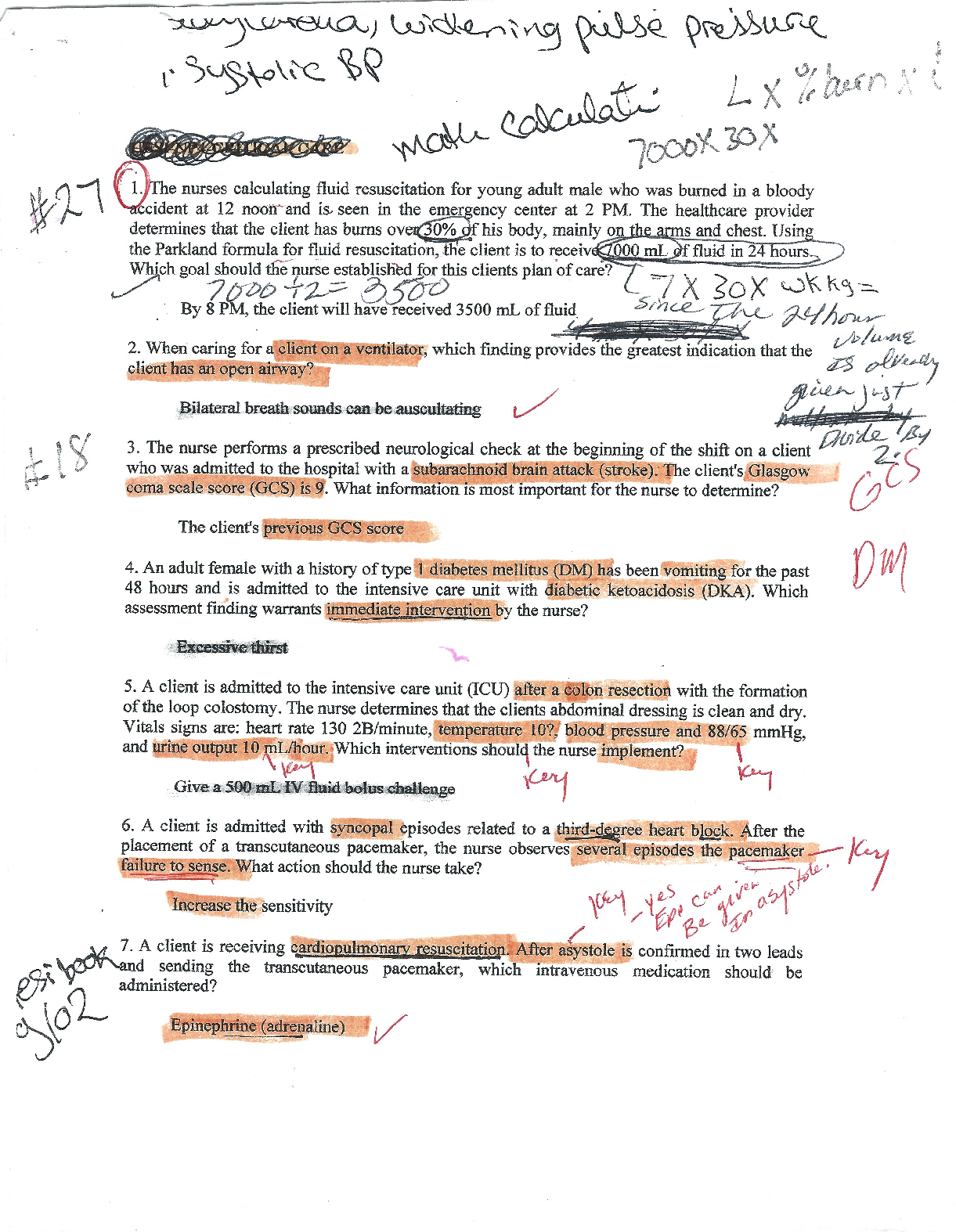


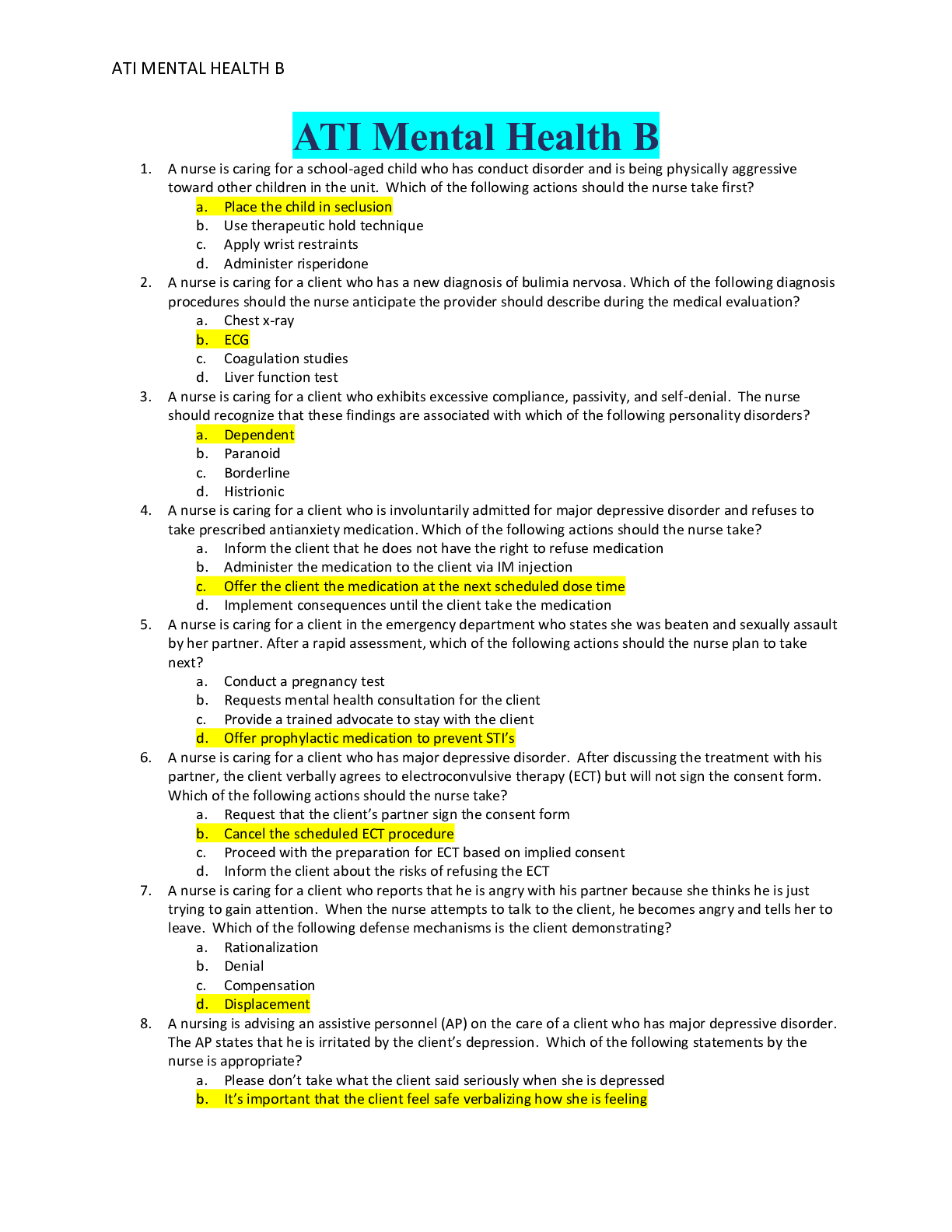
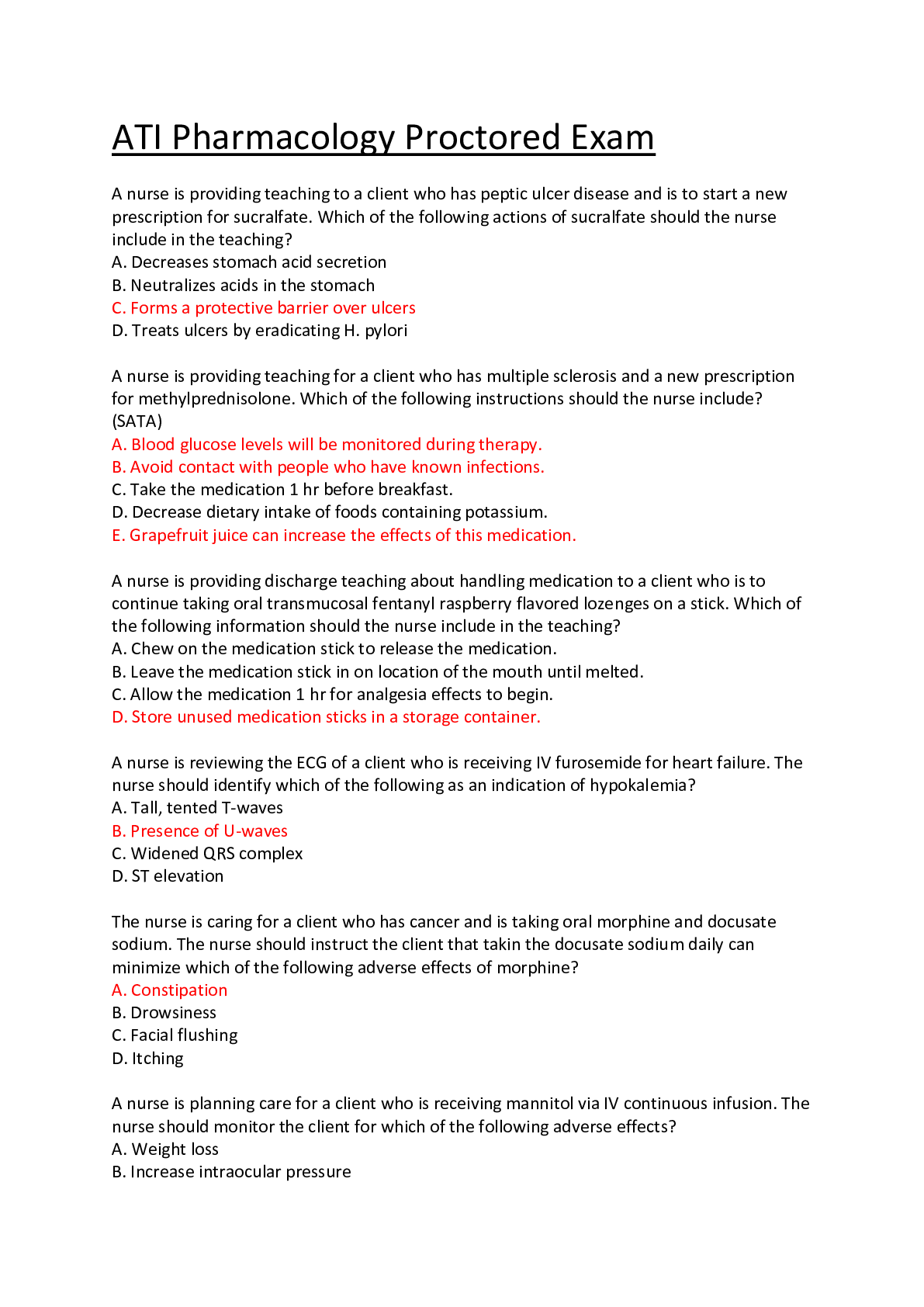
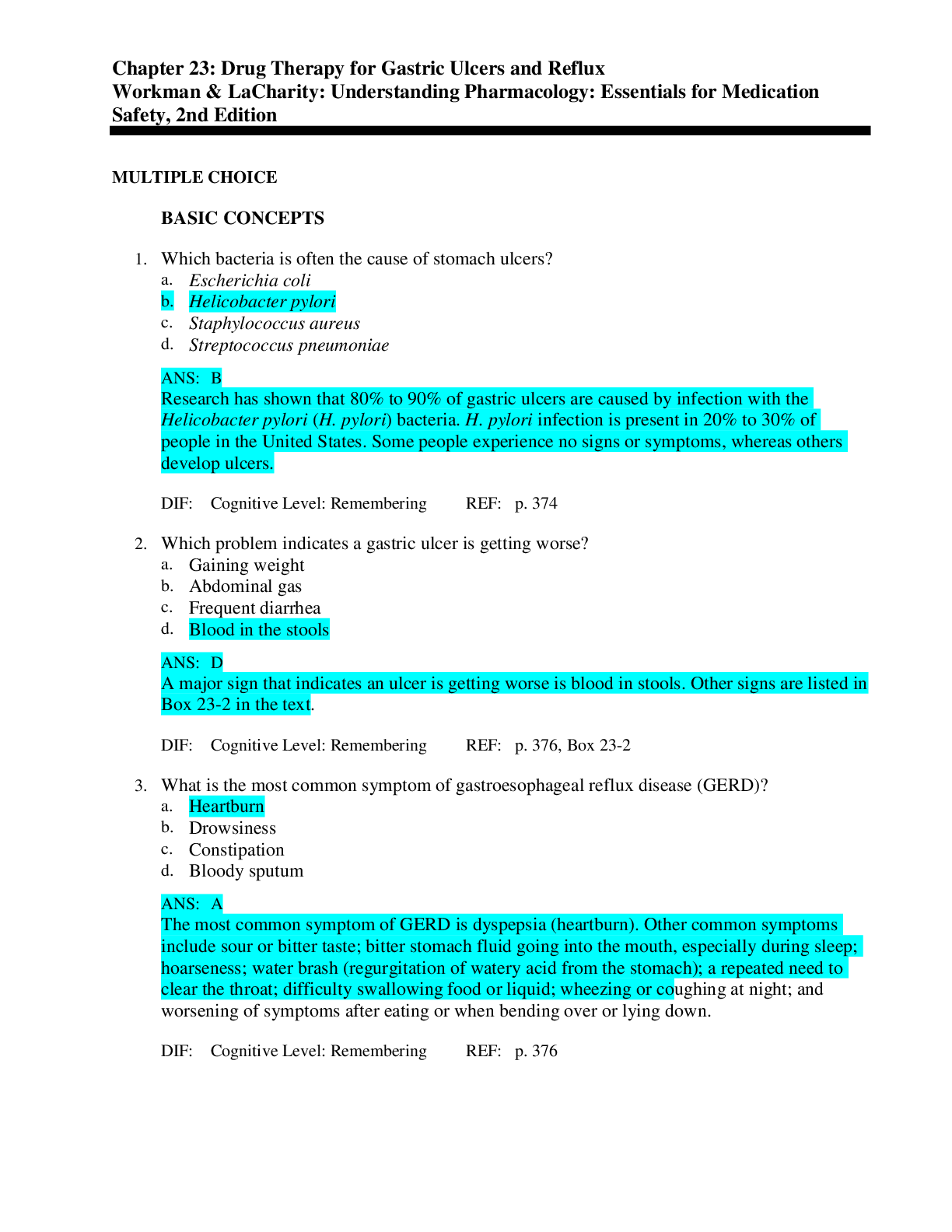
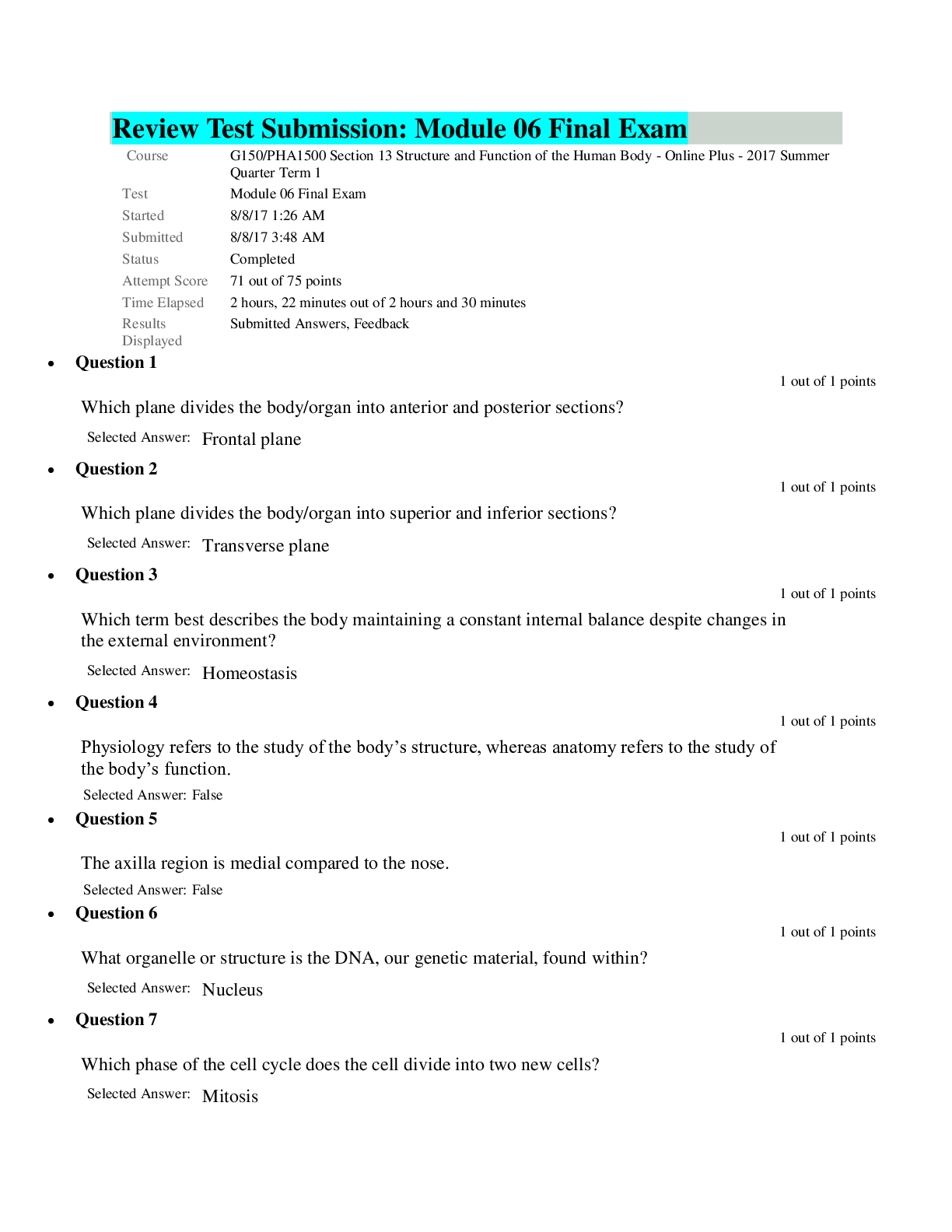

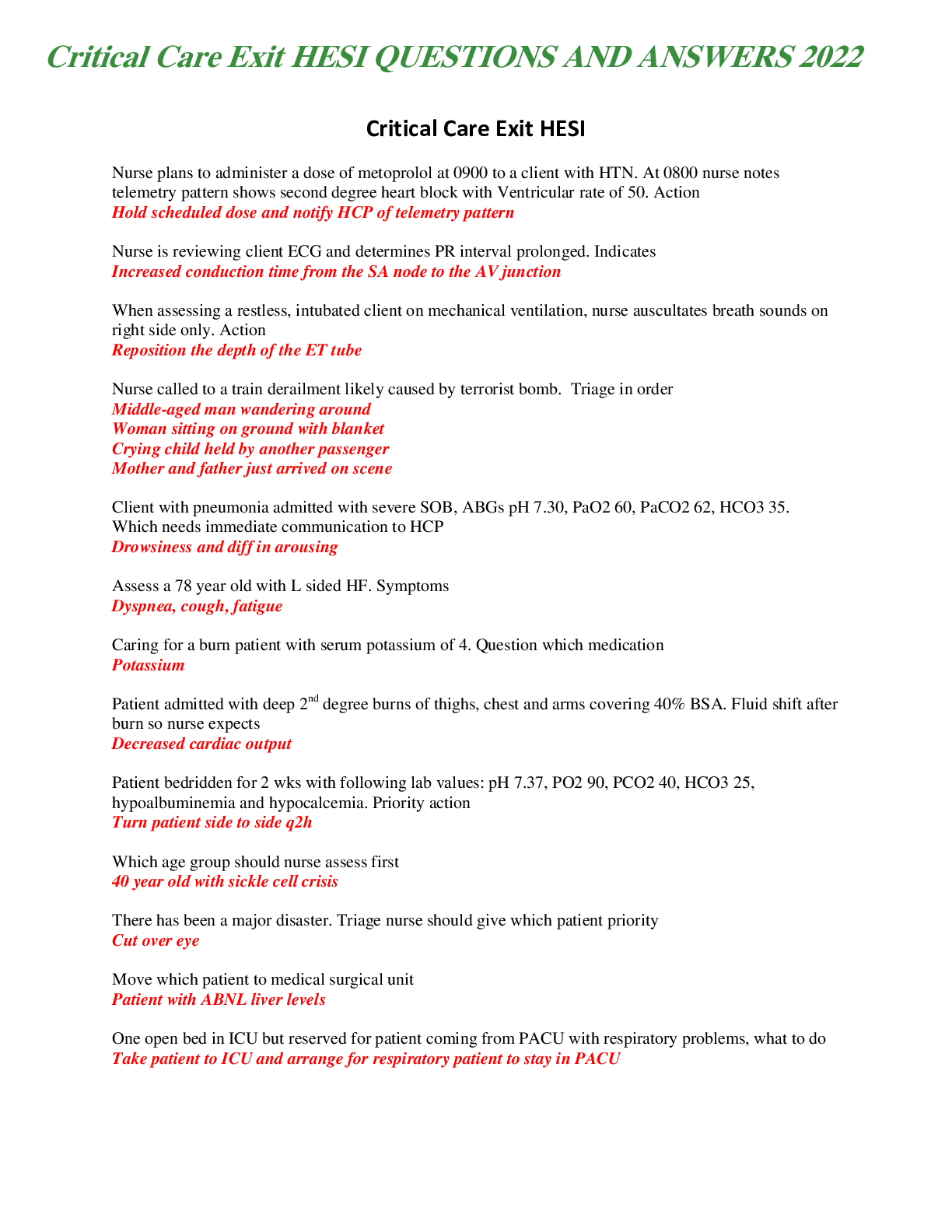

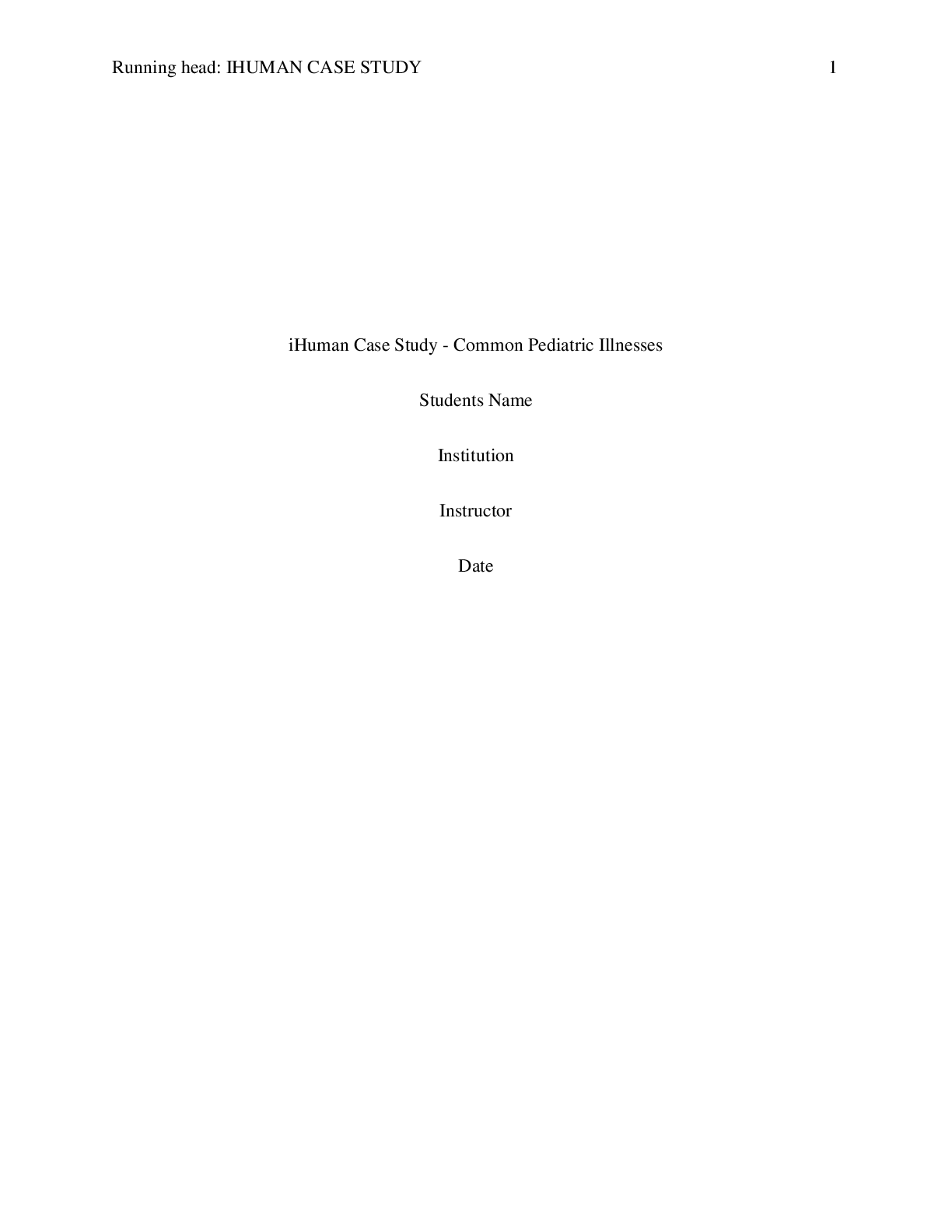
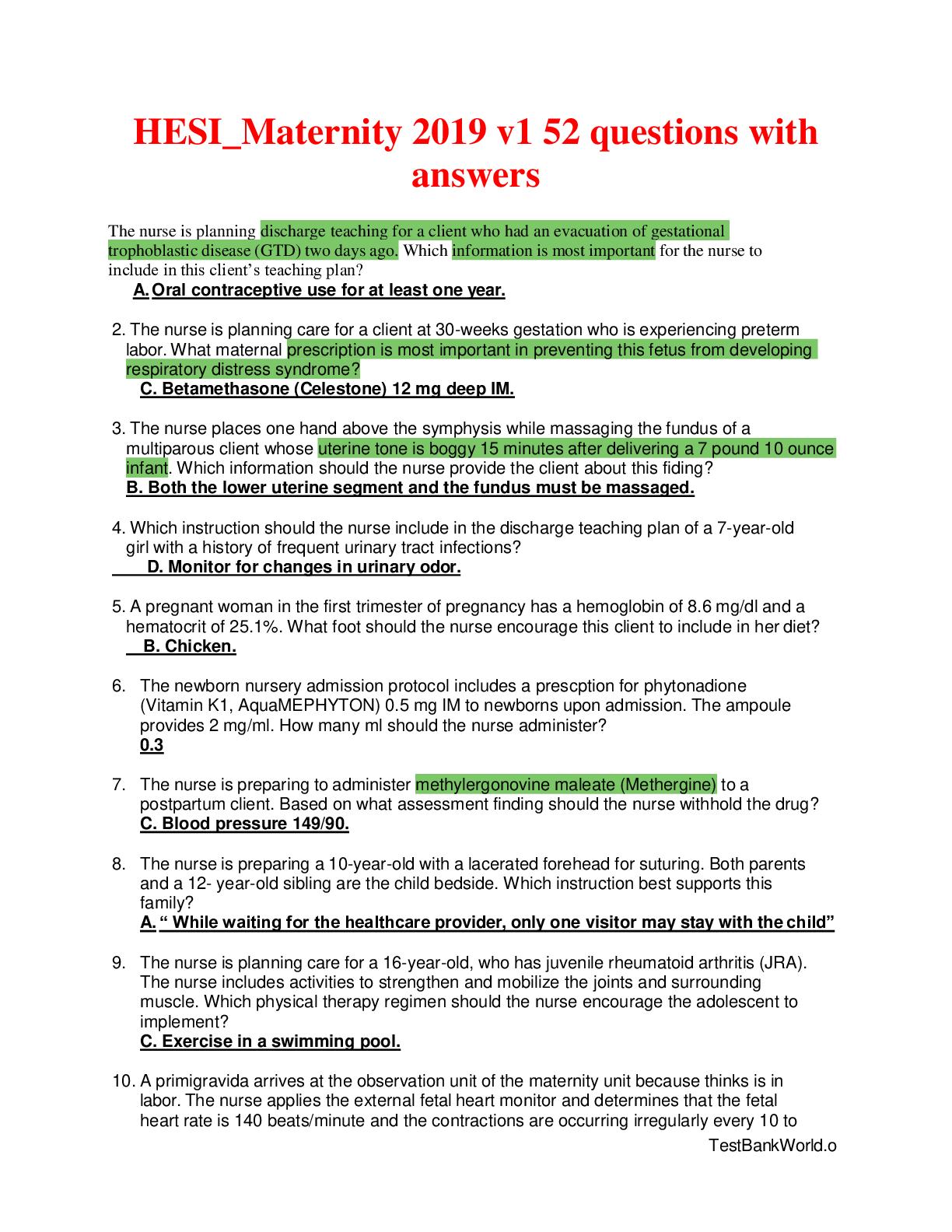
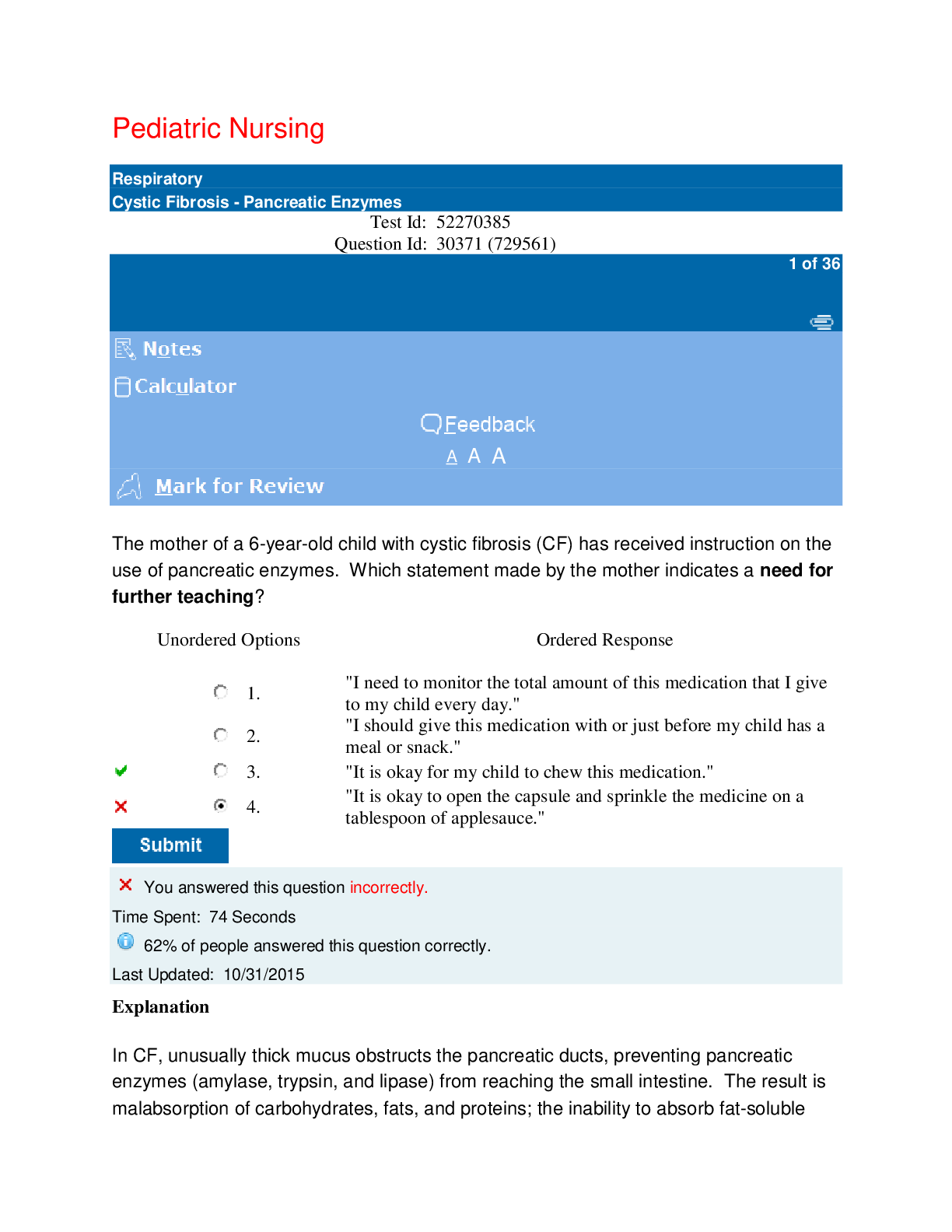
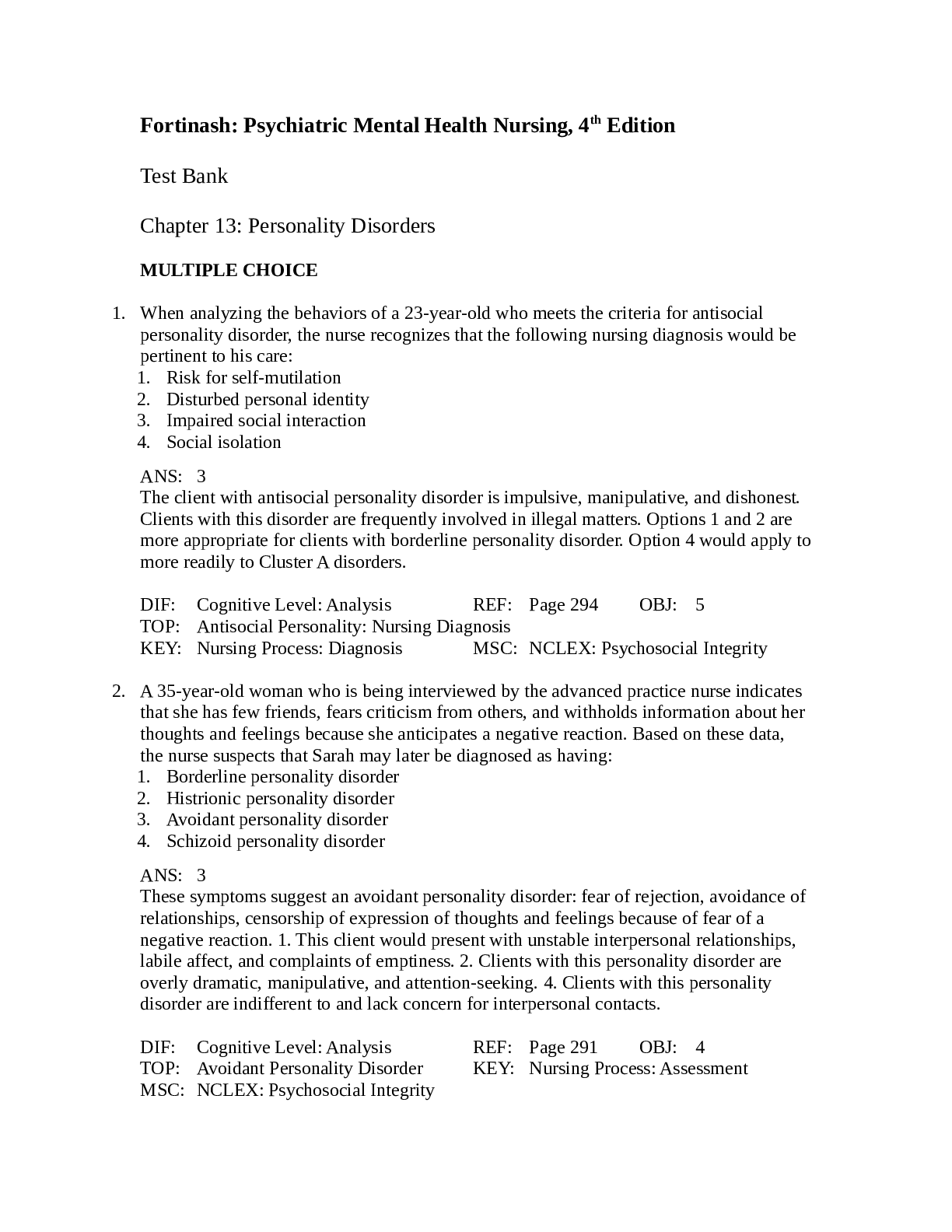
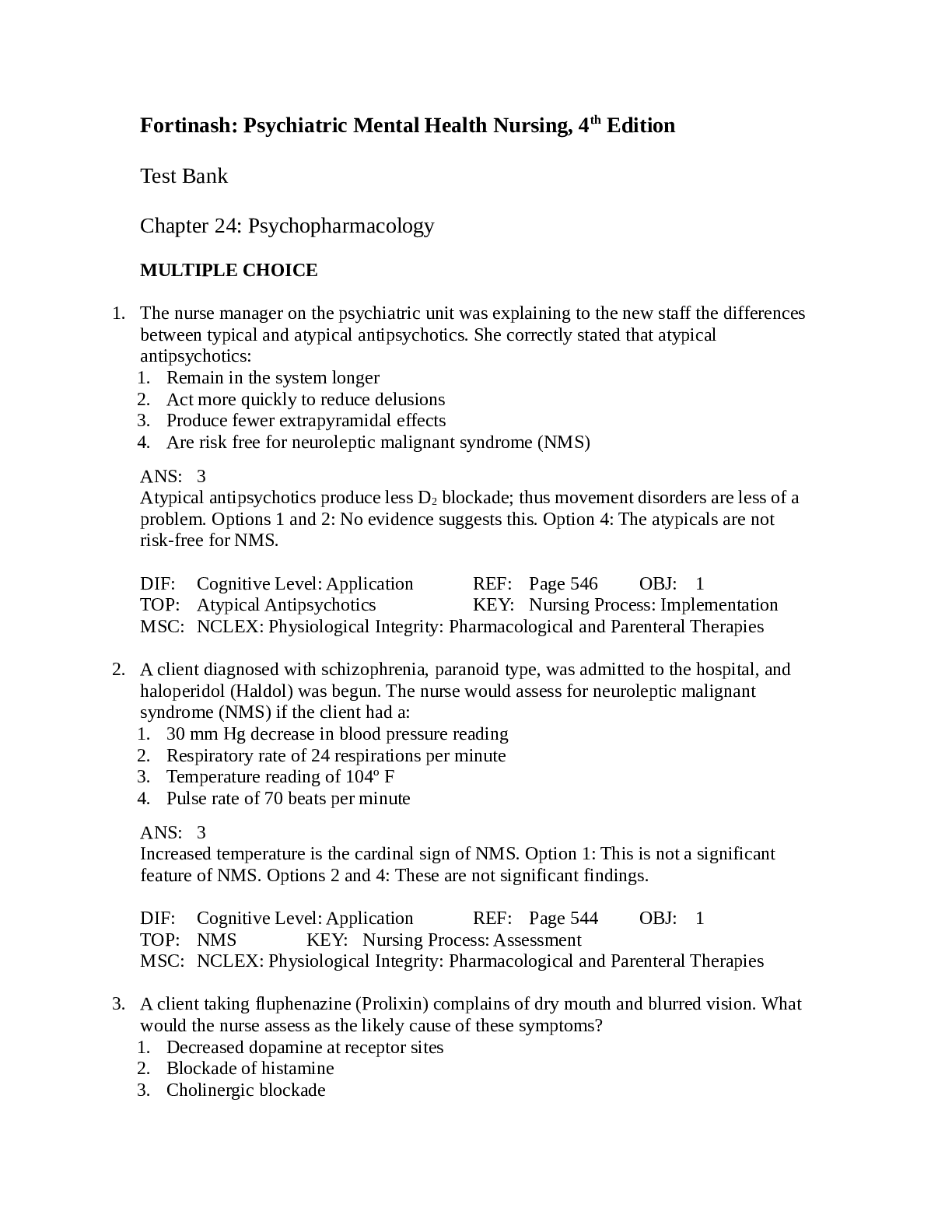
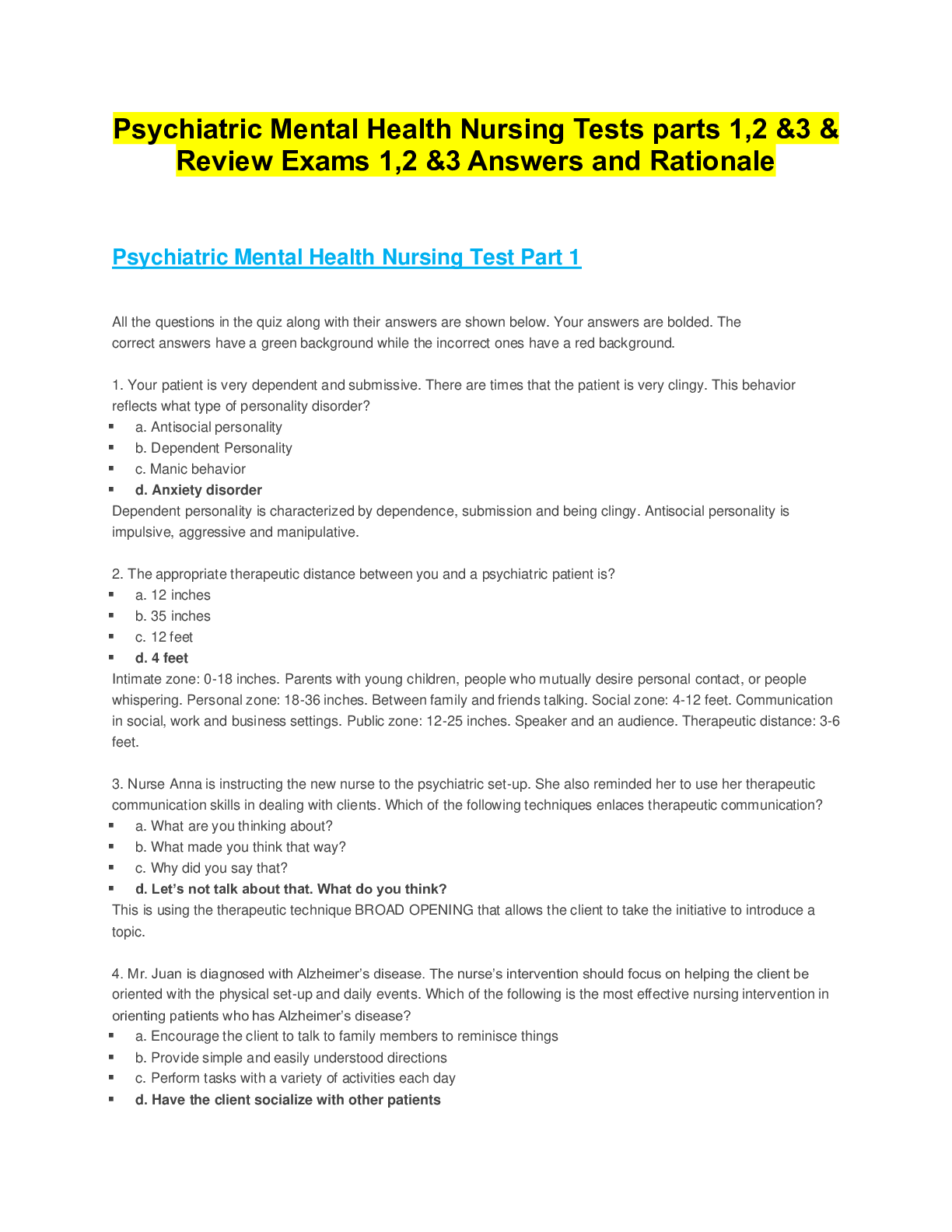
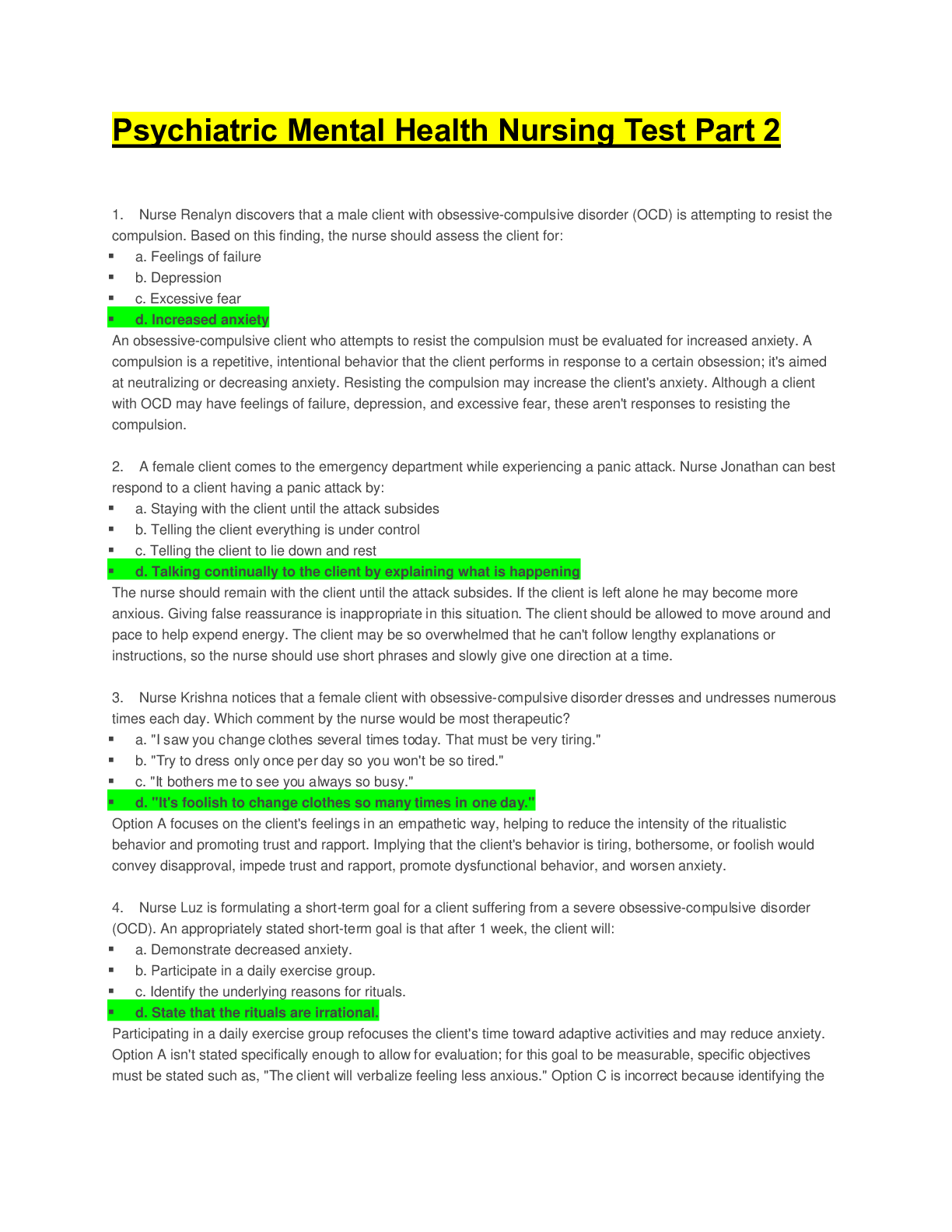
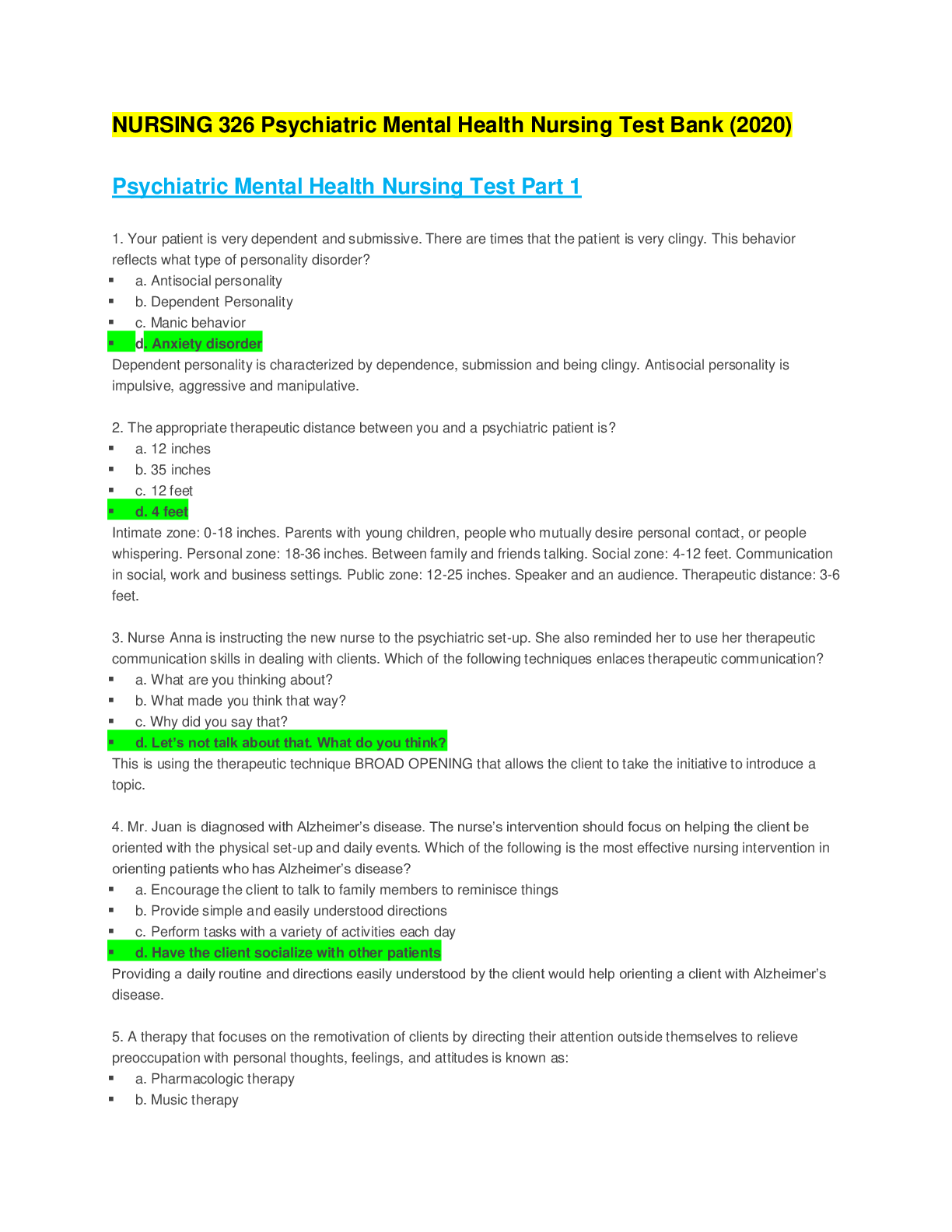
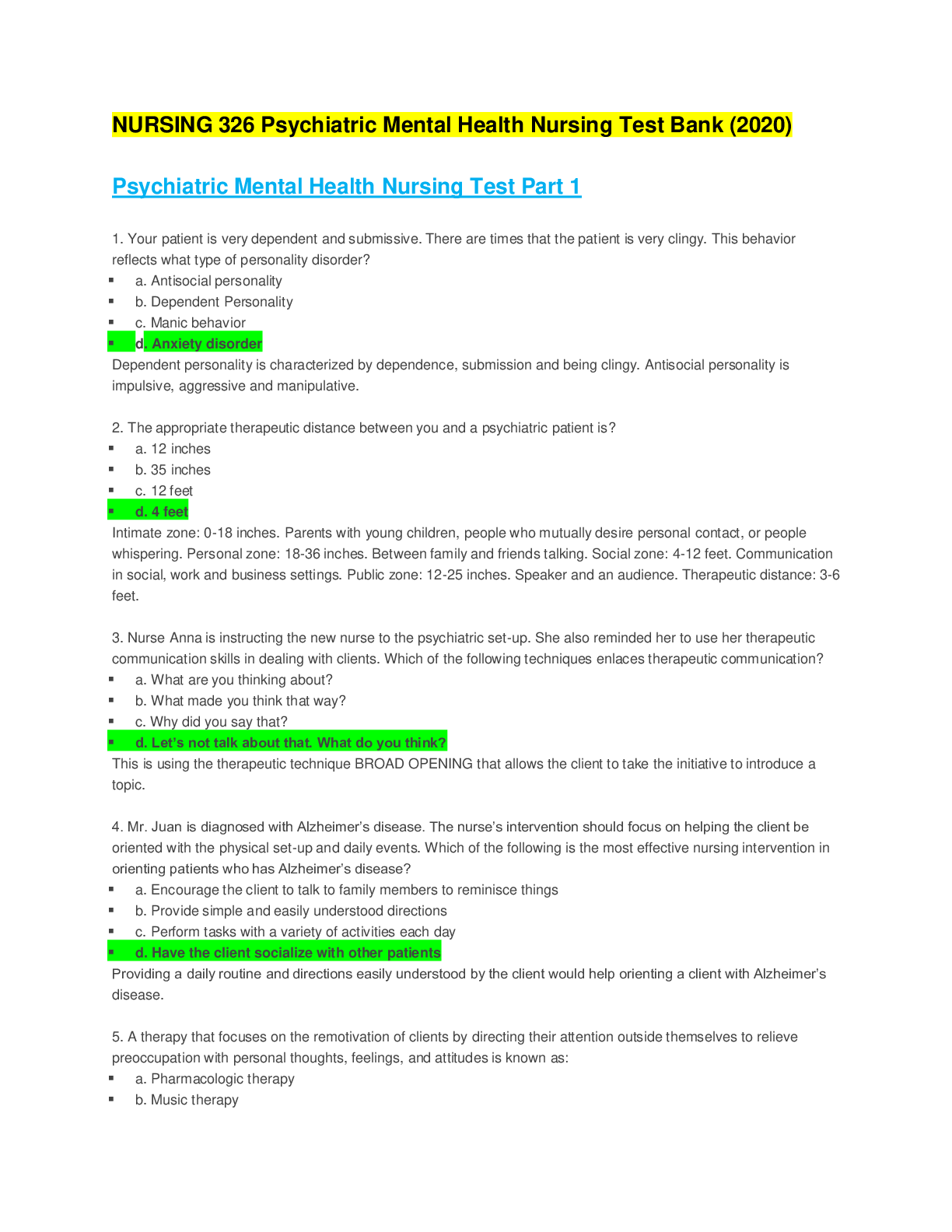



.png)

.png)

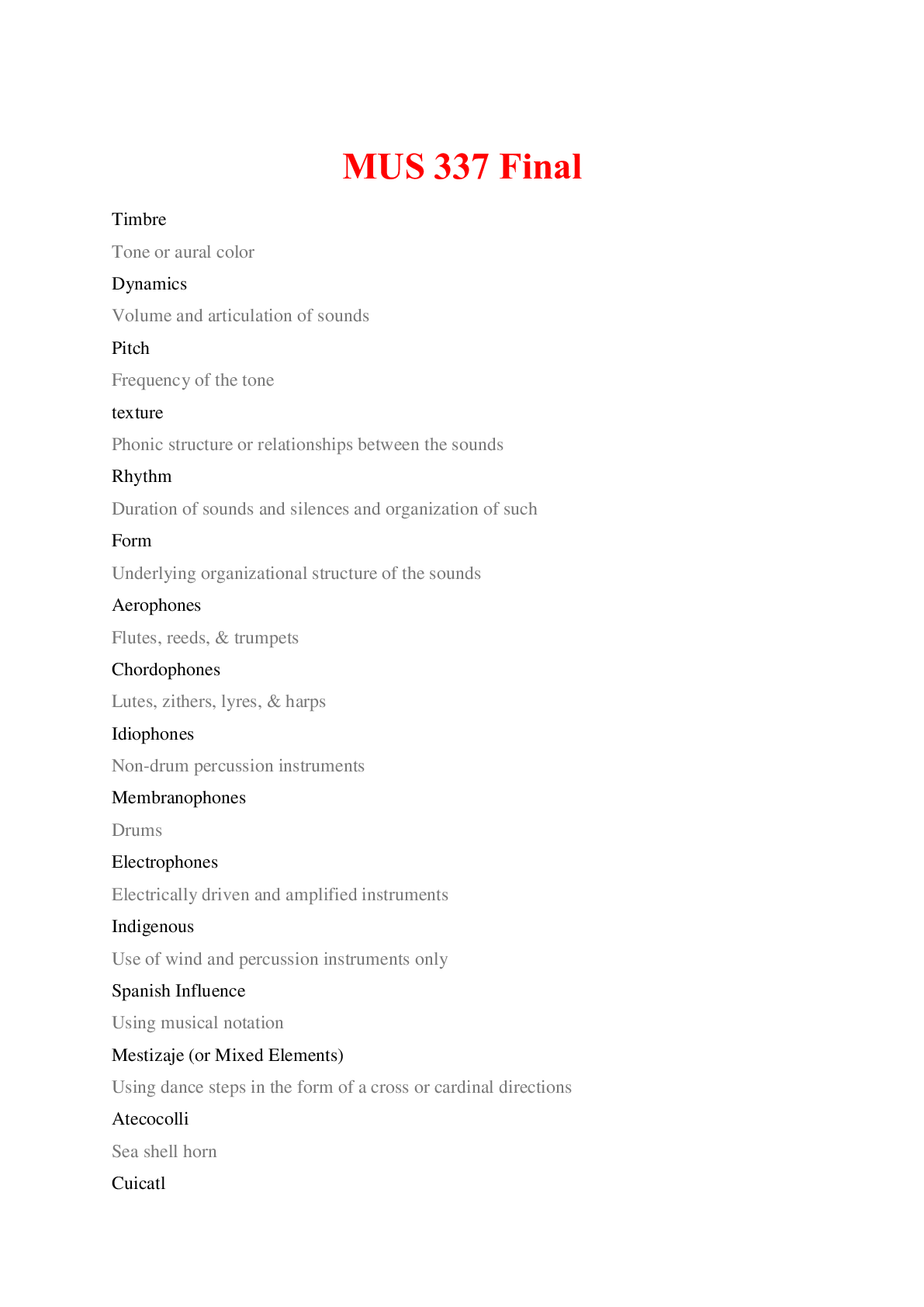

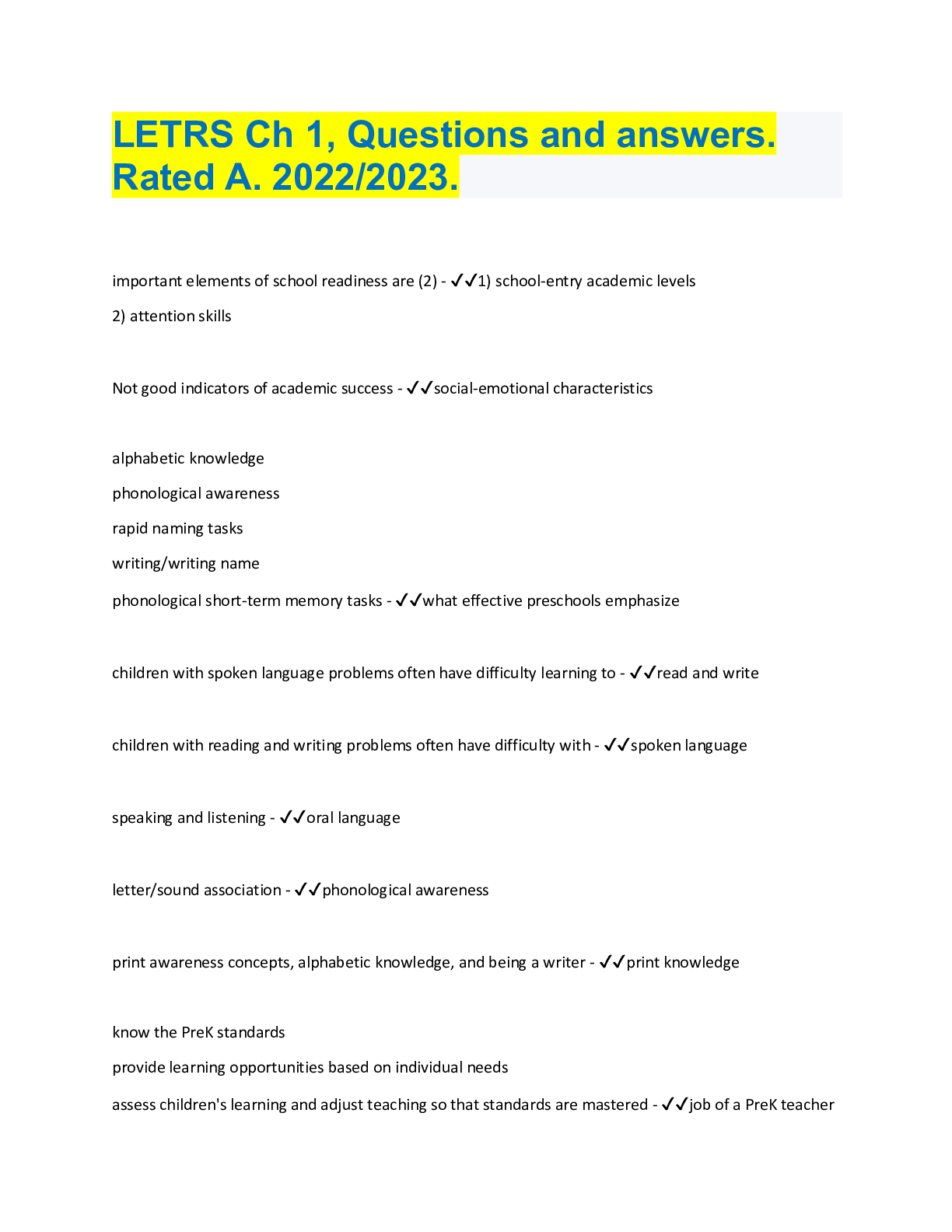
.png)
.png)

.png)

